CLICK ANY OF THE UNITS BELOW TO START YOUR STUDIES
UNIT 1 FACTORS OF PRODUCTION
UNIT 2 MARKETING FUNCTIONS
UNIT 3 WATER CYCLE
UNIT 4 WATER POLUTION
UNIT 5 WATER CONSERVATION
UNIT 6 SOIL FERTILITY
UNIT 7 SOIL STRUCTURE
UNIT 8 SOIL PROFILE
UNIT 9 SOIL EROSION AND SOIL CONSERVATION
UNIT 10 FARM MACHINERY AND THEIR USES
UNIT 11 SAFETY MEASURES WHEN USING FARM MACHINERY
UNIT 12 MAINTENANCE OF FARM MACHINERY
UNIT 13 TYPES AND IMPORTANCE OF FLOWERS
UNIT 14 FLOWER NURSERY ESTABLISHMENT AND MANAGEMENT
UNIT 15 SITE SELECTION AND LAND PREPARATION FOR FLOWER PRODUCTION
UNIT 16 TRANSPLANTING FLOWERS UNIT 17 MANURE AND FERTILIZER APPLICATION IN FLOWERS
UNIT 18 WEED CONTROL IN FLOWERSUNIT 19 TENDING FLOWERS
UNIT 20 PEST AND DISEASE CONTROL IN FLOWERS
UNIT 21 HARVESTING FLOWERS
UNIT 22 TYPES AND IMPORTANCE OF VEGETABLES
UNIT 23 NURSERY ESTABLISHMENT AND MANAGEMENT FOR LEAF VEGETABLES
UNIT 24 SITE SELECTION AND LAND PREPARATION FOR GROWING LEAF VEGETABLES
UNIT 25 TRANSPLANTING LEAF VEGETABLES
UNIT 26 FIELD MANAGEMENT PRACTICES FOR LEAF VEGETABLES
UNIT 27 IMPORTANCE OF RABBITS
UNIT 28 HOUSING AND FEEDING RABBITS
UNIT 29 DISEASE AND PARASITE CONTROL IN RABBITS
UNIT 30 IMPORTANCE AND SYSTEMS OF AGROFORESTRY
UNIT 1 FACTORS OF PRODUCTION
Factors of production are the resources that are used to produce crops and livestock.
MAJOR FACTORS OF PRODUCTION
- land
- labour
- capital
- management
- Land
This is where most of the farming activities take place.
THE CHARACTERISTICS OF LAND THAT AFFECT AGRICULTURAL PRODUCTION
- Size
- Fertility
- Slope
Size:
- If a farmer cultivates a big area, the total yield will be more than from a tiny land.
Fertility:
- A fertile land has enough nutrients, air and moisture for crop growth. Such land will yield more crops.
Slope:
- Land with a gentle slope maintains its top soil because it is not easily eroded. Such land supports plant growth.
- Labour
- This is the effort of people in doing farm operations or work done by people.
- Capital
- This refers to materials available on the farm for production.
- Capital items are cash, farm inputs, equipment, tools, buildings and livestock.
- Management
- This refers to the farmer's knowledge and skills in performing farm operations.
Farm management involves:
- planning the farm work
- controlling the use of land, labour and capital
- supervising the work
- making farming decisions
- budgeting for farm activities
- organizing the land, labour and capital
UNIT 2 MARKETING FUNCTIONS
Marketing functions are activities conducted by producers or intermediate buyers in order to make profit and satisfy the needs of customers.
MARKETING FUNCTIONS
Marketing does not only involve buying and selling. Marketing involves many activities.
These include:
- buying
- selling
- processing
- grading
- packaging
- advertising
- storage
- transporting
- market research
Buying
- This means paying for goods to own them.
ACTIVITIES INVOLVED IN BUYING
- determining needed goods
- identifying where to obtain the goods
- choosing desired goods
- bargaining
- paying for goods
- collecting the goods for use
IMPORTANCE OF BUYING
- the buyer becomes the owner of the goods in order to use them when needed.
Selling
ACTIVITIES INVOLVED IN SELLING
- deciding where to sell
- displaying products to attract customers
- pricing products
- issuing or offering the produce to the customer
- collecting payment
IMPORTANCE OF SELLING
- It enables the farmer to obtain a reasonable income which can be used to buy inputs for the farm business or to satisfy personal needs.
Processing
- Processing means changing the raw materials into finished products. Processing increases the value and usefulness of agricultural products.
_clip_image002.jpg)
Agricultural raw materials and their processed products
ACTIVITIES INVOLVED IN PROCESSING
ª grinding
ª pounding (milling)
ª cleaning
ª shelling
ª boiling
ª sieving
ª winnowing
ª drying
ª slicing
ª salting
Transporting
- This involves carrying the agricultural produce to the market.
IMPORTANCE OF TRANSPORTING GOODS TO THE MARKET
- Goods are made readily available to customers.
- The farmer can also easily sell the produce at a better price since many customers at the market will compete to buy the produce.
ACTIVITIES INVOLVED IN TRANSPORTING
- assembling
- identifying mode of transport
Market research
- This involves finding out prices of various products in different markets.
IMPORTANCE OF MARKET RESEARCH
- Market research helps the farmer in deciding what to produce and where to sell it.
ACTIVITIES INVOLVED IN MARKET RESEARCH
- interviewing people
- recording responses
- interpreting information
Grading
- This involves sorting out produce to ensure uniformity in quality.
Different types of agricultural produce are graded differently depending on certain factors.
FACTORS FOR GRADING
- size
- shape
- colour
- tenderness
- taste
- age
- weight
ACTIVITIES INVOLVED IN GRADING
- sorting
- weighing
IMPORTANCE OF GRADING
- it helps in pricing the produce
- it enables the farmer to get more money for produce of high grade
- it encourages the farmer to aim at producing quality products.
Packaging
- This involves placing the produce into appropriate containers.
ACTIVITIES INVOLVED IN PACKAGING
- wrapping
- sealing
- labelling
- weighing
IMPORTANCE OF PACKAGING
- it makes pricing the produce easy
- it makes it easy for customers to choose produce in quantities suitable for their needs
- it makes it easy for customers to carry produce in quantities suitable for their needs
Storage
- This involves keeping the produce in a safe place
ACTIVITIES INVOLVED IN STORAGE
- application of chemicals
- cleaning storage facility
- stocking
IMPORTANCE OF STORAGE
- it preserves the quality of the produce
- it makes the product available when customers need it most
- it helps the farmer to sell at a better price to increase profit
Advertising
- This involves telling people about a product, letting the customers know why it may be best for them to buy it.
ACTIVITIES INVOLVED IN ADVERTISING
- displaying
- attractive wrapping
- labelling
IMPORTANCE OF ADVERTISING
- it helps in increasing sales
UNIT 3 WATER CYCLE
MEANING OF THE TERM ‘WATER CYCLE’
Water cycle is the continuous movement of water on above and below the surface of the earth in different forms.
or
Water cycle is the continuous movement of water on, above and below the surface of the earth in different forms.
These forms can be liquid, gas or solid.
Since it is a cycle, there is no beginning or ending.
PROCESSES AND STAGES OF WATER CYCLE
Some of the processes and stages are evaporation, transpiration, condensation, precipitation, surface run-off and infiltration.
_clip_image005.gif)
- Evaporation
Evaporation is the loss of water from soil and water bodies into the atmosphere in form of vapour.
- Transpiration
Transpiration is the loss of water from plant leaves into the atmosphere through plant openings in form of vapour.
The combination of evaporation and transpiration is called Evapotranspiration.
- Evapotranspiration
Evapotranspiration is the loss of water from the soil, oceans, lakes, rivers and plants into the atmosphere as vapour.
- Condensation
Condensation is the process by which water vapour in the atmosphere is changed into droplets. When there is an accumulation of water droplets clouds are formed.
- Precipitation
Precipitation is the falling of water from the atmosphere to the earth in form of rain and hail. Precipitation is also called rainfall.
- Surface run-off
Surface run-off is the water that flows on the soil surface following the slope of the land.
- Infiltration
Infiltration is the entry of water into the soil.
- Percolation
Percolation is the moving deeper of water in the soil increasing the amount of ground water.
- Ground water
Ground water refers to large amounts of water stored below the earth's land surface.
- Open water bodies
Open water bodies refers to water existing on the land surface such as rivers, lakes, ponds, oceans and dams.
UNIT 4 WATER POLLUTION
Pollution is the contamination of the environment with harmful and poisonous substances arising from human activities.
CAUSES OF WATER POLLUTION
- disposal of human wastes
- constructing pit latrines close to water bodies
- disposal of domestic, industrial and hospital wastes into water bodies
- siltation of water bodies
- use of poisonous herbs and chemicals when catching fish
- application of fertilizers, herbicides and pesticides to crops in the field which are then eroded together with soil into nearest water bodies
EFFECTS OF WATER POLLUTION ON AGRICULTURAL PRODUCTION
- reduced work done by the farmer
- death of plants
- death of livestock
- blocking irrigation pipes
- shortage of water for irrigation
![]() FUTURE’S WHEELS SHOWING CONSEQUENCIES OF WATER POLUTION
FUTURE’S WHEELS SHOWING CONSEQUENCIES OF WATER POLUTION
_clip_image003.gif)
_clip_image005.jpg)
WAYS OF CONTROLLING WATERPOLLUTION
- building proper and well located pit latrines
- using recommended chemicals in proper amounts for agricultural activities
- avoid urinating, defecating, bathing washing clothes and dishes in water which is used for drinking, animal production and irrigation
- avoid damping kitchen, industrial and hospital wastes in water bodies
- protecting wells and boreholes by fencing them and cementing the floor
- provide ground cover to prevent siltation
WAYS OF KEEPING WATER SAFE
- boiling
- adding chemicals such as chlorine and water guard
- filtering
- protecting boreholes and wells
- siting pit latrines away from water sources
UNIT 5 WATER CONSERVATION
Water conservation refers to the ways of reducing water loss from soil allowing more water to infiltrate in the soil and collecting surface run-off for future use.
WAYS OF CONSERVING WATER
- use of vegetative cover
- application of organic matter
- mulching
- use of contour ridges, bands and box ridges
- constructing dams
- removing silt and other material that accumulate in water bodies
- making ridges across the slope
- maintaining vegetative cover along river bank
- water harvesting
UNIT 6 SOIL TEXTURE
Soil texture is the coarseness or fineness of the soil.
or
Soil texture is the percentage of sand, silt and clay in a soil.
CLASSIFICATION OF SOILS BASED ON TEXTURE
There are three main classes of soil based on texture. These are sand, clay and loam soils.
CHARACTERISTICS OF CLASSES OF SOIL
Class of soil |
Characteristics |
Sand |
|
Loam |
|
Clay |
|
SOME CROPS SUITABLE FOR DIFFERENT SOIL CLASSES
Class of soil |
suitable crops |
Sand |
cassava, groundnuts, Irish potatoes, sweet potatoes |
loam |
maize, groundnuts, beans, peas, pigeon peas, tobacco, okra, Irish potatoes, soya beans |
clay |
rice, sugarcane, cotton |
UNIT 7 SOIL STRUCTURE
Soil structure is how soil particles are held together.
or
Soil structure is the arrangement of soil particles to form different shapes.
CHARACTERISTICS OF DIFFERENT SOIL STRUCTURES
There are different types of soil structures. Some of these soil structures are loose, crumb and compact.
Loose structure
- the individual soil particles are lightly held together
- it has large pore spaces between the particles
- it loss water quickly
- it is very easy to break
Crumb structure
- the individual soil particles are moderately held together
- it has medium pore spaces between the particles
- it breaks quickly
- it holds moderate amount of water
Compact structure
- the individual soil particles are strongly held together
- it has very mall pore spaces between the particles
- it loss water quickly
- it is difficult to break
- it holds high amount of water
UNIT 8 SOIL PROFILE
Soil profile refers to the vertical section through the soil showing horizontal layer.
Most soils have four main layers.
These are top soil, sub soil, weathered rock and parent rock.
_clip_image007.jpg)
LAYERS OF SOIL AND THEIR CHARACTERISTICS
Top soil
- This is upper layer of soil profile.
- Most living organisms are found in this layer.
- This layer has a high organic matter content.
- This gives the layer its dark brown or black colour, better aeration and high nutrient content.
Sub-soil
- This layer lies below the top soil.
- There is less organic matter or humus.
- This layer has a lighter colour than top soil.
- The colour may be red or reddish brown.
- The layer contains some nutrients washed down from top soil.
The washing down of nutrients from top soil to the sub soil is called leaching. Roots of most crops do not reach this layer.
Generally, the sub soil is less fertile than top soil.
However, some deep rooted crops such as trees may penetrate this layer.
Weathered rock
- This layer lies below the sub-soil. It contains gravel, broken rocks.
- The colour of this layer varies.
- It depends on the mineral composition of the rock and penetrate this layer.
Parent rock
- This is a rock which has not been broken down to form soil.
- It is also called a bed rock.
THE CHARACTERISTICS OF TOP SOIL THAT PROMOTE CROP PRODUCTION
Characteristics |
Importance for crop production |
high nutrient content |
supplying adequate amount of plant food for growth |
better aeration |
supply air (oxygen) needed for seed germination and root respiration |
better water retention |
supply adequate water for seed germination and plant growth |
black colour |
it helps the soil to absorb heat which provide warmth necessary for seed germination and seedling development |
high humus content |
humus improves soil aeration, water retention and nutrient content of the soil |
presence of soil organisms |
these help to improve soil aeration like earth worms |
UNIT 9 SOIL EROSION AND CONSERVATION
Soil erosion
Soil erosion is the removal of top soil by the action of water and wind.
CAUSES OF SOIL EROSION
- careless cutting down of tree
- cultivating on steep slopes
- cultivating along river banks
- making ridges along the slope
EFFECTS OF SOIL EROSION
- loss of fertile soil resulting into low yields
- reduced amount of ground water as a result of fast moving water which reduces infiltration
- silting of rivers, streams, dams and lakes reducing the amount water bodies and destroying aquatic life
- formation of gullies leading to reduction of land for cultivation
- exposure of plant roots causing lodging of crops
SOIL CONSERVATION
- avoiding overstocking
- making terraces on steep land
- mulching
- correct spacing of crops
- strip cropping
- making ridges across the slope
- making box ridges
- making contour bands
_clip_image009.jpg)
TERRACES ON STEEP SLOPE
Making terraces on steep slopes. This conserves soil by reducing the speed of running water.
_clip_image011.jpg)
MULCHING
Mulching material reduces the speed of running water which can carry soil away.
_clip_image013.jpg)
STRIP CROPPING
Strip cropping involves alternating strips of poor cover crops (maize) with good cover crops (groundnuts) across the slope.
The soil that has been eroded by poor cover crops is trapped by good cover crops.
_clip_image015.jpg)
RIDGES ACROSS THE SLOPE
Making ridges across the slopes reduces speed of run-off
_clip_image017.jpg)
BOX RIDGES
Making box ridges reduces amount of run-off by holding water in the boxes.
_clip_image019.jpg)
CONTOUR BANDS
Making contour bands holds water and reduces amount of run-off thereby controlling erosion.
UNIT 10 FARM MACHINERY AND THEIR USES
FARM MACHINERY AND THEIR PARTS
There are different machinery that farmers use. These include ploughs, ridgers and sprayers.
USES OF FARM MACHINERY
MACHINERY |
USES |
plough |
tilling the soil |
ridger |
making ridges |
sprayer |
applying chemicals to crop and animals to control pests, parasites and diseases. |
_clip_image002_0000.jpg)
PARTS OF A RIDGER
PARTS OF A PLOUGH
_clip_image004.gif)
PARTS OF A SPRAYER
_clip_image006.jpg) Control tap
Control tap
USES OF PARTS OF PLOUGH AND A RIDGER
PARTS |
USES |
handles |
enable the farmer to hold and guide plough and ridger |
beam |
holds all parts of a plough or a ridger |
share |
Cuts the soil into thin layer |
hake |
sets the depth of ploughing |
depth wheel |
helps to move the plough or ridger and maintains depth |
hitch |
attaches the plough or ridger to the chain or axle |
mould board |
throws the soil cut loose by share to one side and turns it over (for plough) |
wings (for ridger) |
pushes the soil to each side so that on the return run a complete ridge is made during ridging |
USES OF PARTS OF A SPRAYER
PARTS |
USES |
plastic container |
holds the spray materials |
plain pump barrel |
creates pressure which forces the spray to come out through the lance |
lance |
delivers the spray |
nozzle |
a hole through which the spray comes out |
control tap |
helps to control the amount of spray that comes out |
sieve |
filtering the spray to avoid blocking the nozzle |
shoulder strap |
for holding the sprayer |
nozzle cups |
holds nozzle disc in position |
UNIT 11 SAFETY MEASURES WHEN USING FARM MACHINERY
SAFETY MEASURES WHEN USING PLOUGHS AND RIDGER
- Ensure that the machine is in good working order
- Soil must be fairly moist when either ploughing or ridging
- There must be no stumps or large stones in the field during ploughing or ridging
- The plough or ridger must be handled firmly and correctly
- The nuts and bolts must be tight
- Oxen used to pull the plough or ridger must be well trained
- The yoke must be tied to the plough property
SAFETY MEASURES WHEN USING SPRAYER
- keep the control tap tight.
- avoid sucking or blowing through the nozzles to prevent chemical poisoning
- always wear protective clothes when spraying
- face away from the wind side when spraying so that chemicals are not blown into the face.
- do not eat, drink or smoke while spraying.
- the sprayer must be thoroughly cleaned after use
- wash your body with soup after spraying
- chemicals from the sprayer must be properly disposed of to avoid pollution of air, soil and water.
UNIT 12 MAINTENANCE OF FARM MACHINERY
MAINTENANCE OF A RIDGER, A PLOUGH OR SPRAYER
Remember the following points or rules when caring for a ridger, plough and sprayer:
J know the parts and how they work or function
J set the machine correctly for it to perform properly
J clean the machines and dry them immediately after use to prevent rusting
J grease all movable parts to prevent friction between them
J tighten nuts and bolts to prevent spoiling the threads on the nuts and bolts
J replace warn out parts such as the share, mould boards, nozzle and handle.
J transport a plough or a ridger properly in an ox-cart or by tying the handles to the york and pulling it on the depth wheel in reverse position.
J paint the machinery at the end of each growing season
J keep plough, ridger or sprayer in dry store room or shed for safety
J use the machine for purposes it was made
J read the accompanying manual if available
J lift up or lay down the machinery after use and avoid throwing them away anyhow
UNIT 13 TYPES AND IMPORTANCE OF FLOWERS
TYPES OF FLOWERS
There are different types of flowers based on how they grow.
- creepers or climbers
These flowers have stems which need support because the stems are weak and grow along the ground. The flowers look beautiful when supported by a wall, strings, trees and fences. Examples of the creepers are money plant, and bougainvillea.
- ground covers
These flowers have stems which do not grow tall. The stems do not need support. The flowers produce many side branches and cover the ground. Examples of such flowers are geranium, periwinkle, marigolds, zinnia, dahlia and ferns.
- trees
These flowers have stems that grow very big and tall. The stems are also tough. The trees are grown because they produce beautiful shape, fruits, petals and leaves. Examples of such flowers are jacaranda, acacia and conifers.
- shrubs
These have stems which are thick and tough after first year of growth. They produce many branches which can be trimmed to a variety of shapes. Examples of such flowers are hibiscus, roses, fushsia, and poinselta.
IMPORTANCE OF FLOWERS
J They decorate the surrounding
J Source of income
J Source of medicine
J Source of raw material
J Provide protection
J Some flowers are grown to scare away harmful pests and other animals such as marigold and night queen.
UNIT 14 FLOWER NURSERY ESTABLISHMENT AND MANAGEMENT
ESTABLISHMENT OF FLOWER NURSERIES
Establishment a flower nursery involves site selection, land preparation, planting or sowing, weeding, pest and disease control and hardening off.
Site selection
FACTORS TO CONSIDER WHEN CHOOSING A SITE FOR A FLOWER NURSERY
- Should be close to water supply for easy watering
- Should be close to home or office or fenced area for protection
- Loam soil for good drainage
Land preparation
Land preparation involves the following:
- clearing the land
- constructing a fence
- preparation of planting materials
Preparing nursery bed
Preparation nursery bed for cuttings
- till the cleared site to break to break the hard subsoil so that water drains freely
- level the tilled land to make the plate flat
- mark the bed 1 metre wide 5 centimetre high using bricks, soil or wood so as to create a basin for easy watering
- fill the marked are with 15 centimetre depth of river sand for free drainage for easy rooting
- cover the top of the prepared bed with a clear plastic paper. This will protect the bed from direct sun heat, too much water from rains and will produce heat that will make buds of cuttings to open quickly
Preparation of nursery bed for seeds
- small seeds can be established in trays with holes at the bottom, large seeds can be sown in the pots filled with soil
- prepare soil to fill trays or pots by mixing top soil rich in manure, sand and madeya or sawdust, rice husks in the ratio 2:1:1
- arrange the trays or planting pots on levelled land to form a 1 metre wide bed
- fill the container with the soil
Planting
Planting cutting
- select planting materials from fresh clean stems to prevent carryover of pests and diseases
- make a 15cm long cutting by making the base flat and making the cut close to a node in order to easily identify the side to place in soil
- cut the top of the cutting in a slanting manner to allow water to drain away
- remove leaves from the cutting except 2 leaves at the top of the cutting for fast growth
- water the planting bed adequately
- plant cuttings 7.5 cm deep and the correct way up and in a slanting manner
- avoid excessive watering to prevent damping off and leaching
Planting large seeds
- make a hole in the potted soil
- place the large seed in the holes
- water the pots adequately
Planting small seeds
- make a drill in planting trays
- sow small seeds in the drill thinly
- cover lightly with soil
- cover the trays with grass
- water the planted trays
MANAGING A FLOWER NURSERY
The activities involves in managing flower nursery include watering, weeding, controlling pests and diseases and hardening off.
- watering should be done twice a day early in the morning and late in the evening
- weed by uprooting
- pests and diseases should be controlled using appropriate measures
- hardening off – before transplanting seedlings reduce frequency of watering so that seedlings withstand field conditions
UNIT 15 SITE SELECTION AND LAND PREPARATION FOR FLOWER PRODUCTION
FACTORS TO CONSIDER WHEN SELECTING SITE FOR GROWING FROWERS
- type of flower
- height of flower
- colour of flower
- colour of surroundings
LAND CHARACTERISTICS
- slope of the land – make use of land characteristics. For instance, on steep land plant ground covers or make terraces for planting flowers, on rocks make a rock garden
- site of the bed – the site of the flower bed will affect the size and type of flower.
If flowers are to be planted between gutter and wall, it may be a narrow bed and choose rooted flowers to avoid damaging the structure.
LAND PREPARATION
When preparing land follow the following steps:
- choose the site for flower garden
- mark the bed according to the desired size and shape
- lay out the bed according to design
- dig the marked area to a depth equal to root depth of flowers DEPTH OF HOLE FOR DIFFERENT TYPES OF FLOWERS
TYPES OF FROWER |
DEPTH OF HOLE |
shrubs |
30 cm deep |
ground cover |
7.5 - 15cm deep |
trees |
90cm deep |
- cover the planting hole with the top soil first, then subsoil mixed with well decomposed manure
UNIT 16 TRANSPLANTING FLOWERS.
STEPS FOR TRANSPLANTING SEEDLINGS INTO FLOWER POTS
- Watering the plants 3 – 4 hours before transplanting so that roots, stems and leaves are full of water as well as the soil around the roots.
- preparing soil for pot filling
- filling soil in flower pots
- making a planting hole
- lifting the seedlings with a hand trowel without damaging the roots
- place the lifted seedlings into the hole made in the planting pot without bending the roots.
- cover the transplanted seedlings up to the collar neck
- press the soil around the seedlings to make seedlings stand firm
- place the potted plants under shed when it is hot season
- water the transplanted plants.
STEPS FOLLOWED WHEN TRANSPLANTING SEEDLINGS TO FIELD BEDS
- water the field bed hole 3 – 4 hours before transplanting
- dig a planting hole
place the pot in the hole
- remove the planting pot by tearing on the side, this is to allow free growth of stem and roots later, circulation of air and water
- cover the plant with soil to the collar neck
- press the soil around the plant to make seedling stand firm
- water the transplanted seedlings
- mulch the seedling to protect from excess sunlight
- water the plant every 4 days until it get established
Transplanting should be done on a cool day or early in the morning or late in the afternoon to reduce loss of water from the seedlings.
UNIT 17 MANURE AND FERTILISER APPLICATION IN FLOWERS
FERTILISER AND MANURE APPLICATION TO FLOWERS
Fertilizers and manure are applied to flowers to encourage growth.
Different types of manure are applied such as compost manure and animal manure. Well decomposed manure should be applied.
The manure can be mixed with soil before transplanting.
When the flowers are well established, the manure can be spread (broadcasted) in the flower beds. Where the flowers are planted in the rows sparsely planted, the manure can be applied in grooves. The common fertilizers applied in the flowers are 23:21:0+4S and CAN.
The fertilizers are applied using dollop method, banding method and broadcasting method depending on how flowers are planted.
Apply 23:21:0+4S soon after transplanting. When flowers are well established apply CAN.
UNIT 18 WEED CONTROL IN FLOWERS
COMMON WEEDS IN FLOWER GARDENS
Some of the weeds in flower gardens are star grass, datura, oxalis, chisoso, Tridax, galisoga. A flower garden has to be free from weeds for it to be beautiful.
METHODS OF WEED CONTROL IN FLOWER GARDENS
In a flower garden, weeds can be controlled using the following methods:
- light hoeing
- hand weeding
- slashing
- chemical weeding
GUIDELINES WHEN WEEDING FLOWER BEDS
- ensure that weeds are well controlled
- avoid destroying the flower plants
- ensure the garden is left neat
WHEN TO USE DIFFERENT METHODS OF WEEDING
METHODS |
WHEN |
hand weeding |
when weeds are very close to plant |
light hoeing |
when space between flowers allows use of a hoe without damaging the flower |
slashing |
when flowers are widely spaced |
chemical weeding |
when controlling weed before they emerge killing the weeds using selective herbicides |
UNIT 19 TENDING FLOWERS
MEANING OF THINNING
Thinning is the removal of excess plants on a flower bed or field.
REASONS FOR THINNING
- to reduce competition between plants and nutrients, air, water, space and sunshine.
- to ensure healthy growth of the flower
- to maintain beauty of the flowers
PROCEDURES FOR THINNING
- water the flower beds to make the soil moist
- uproot the weak, diseased or any excess plants leaving the correct number per station
MEANING OF PRUNING
Pruning is the removal of unwanted parts of a flower plant such as dead, old, excess and diseased branches, leaves and flowers.
REASONS FOR PRUNING
- to improve quality of the flowers
- to maintain plant health
- to restrict growth
- to train the plants
PROCEDUCE FOR PRUNING FLOWER
- remove dead, old and diseased leaves
- remove dead heads and fading flowers
- remove branches which are dead, trailing, diseased, excess and off shape by cutting them from the bottom upward to avoid tearing the flower plant. The cutting should be done at an angle to facilitate water drainage
MEANING OF TRIMMING
Trimming is the cutting back of flower branches.
REASONS FOR TRIMMING
- to make a desirable shape
- to make flower plants become less bushy
- to restrict growth
PROCEDURE FOR TRIMMING
- measure the desirable height and mark
- cut back the branches to the intended height
- cut the branches to the desirable shape
UNIT 20 PEST AND DISEASE CONTROL IN FLOWERS
PESTS AND DISEASES OF FLOWERS
- PESTS OF FLOWER
_clip_image002_0001.jpg)
Mealy bugs
These are found on undersides and axils of leaves and young shoots. They produce a sticky substance called honeydew on which grows a black mould. They live by sucking plant juices. They can be controlled by using clean planting materials.
_clip_image004.jpg)
Aphids
These cause twisting of leaves and flowers. They also produce sticky substances called honeydew that attracts ants. They can be controlled by using dimethoate or marathion, hot pepper and garlic.
Scaley insects
They are identified as bumps on stems and undersides of leaves where they produce substance called honeydew resulting in stunted growth. They live by sucking plant juices. They can be controlled by Marathion or Noadazinon.
White flies
They are found on undersides of the leaves and produce sticky substance called honeydew where a black mould can develop. They live by sucking plant juices. They can be controlled by clean planting materials.
Spider mites
These are found on the undersides of the leaves. They suck plant juices. They can be controlled by interplanting with strong smelling plants like marigold and using Dimethoate, Actellic and Rogor.
Slugs or Snails
They are found around dark, moist, decaying matter. They eat leaves. They can be controlled by hand picking or use of sodium bicarbonate and common salt.
- DISEASES OF FLOWERS Grey mould
- This is caused by fungus.
- It affects leaves, flowers and roots.
- It can be controlled by cutting away the dead rotting part and burn it
- It can also be controlled by fungicides
Beech bark disease
- It is caused by fungus spread by scale insect
- It affects the bark and penetrates inwards until the tree dies
- It can be controlled by felling the infected tree to minimise the spread of disease
Giant polypore fungus
- This disease is caused by fungus
- It usually affects mature or over-mature trees
- It attacks the roots
- It can be controlled by cutting down the tree and burn it
UNIT 21 HARVESTING FLOWERS
There are three products that can be harvested from flowers and shrubs. These are:
- true seeds
- cuttings
- real flowers (cut flower)
PROCEDURE
The best stage to harvest or cut flowers for sale depends on the types of flowers. Generally, flowers must be harvested just before or as soon as they reach maturity. The bud should not be completely open.
Cut the flowers during the cool morning hours. At that time dew should dried.
Use a pair of scissors, garden share, secuture and knives to cut the flower. These materials should be kept sharp to ensure that stems are cut evenly and not crushed. Crushed stems restrict the ability of the flowers to take up water thereby reducing their life.
PRESERVING FLOWERS
- Air drying
Flowers are cut at uniform length and hang upside down in branches in a dark, dry room to prevent fading of colour through sunlight
- Pressing
Flowers are pressed between newspapers. Alternating layers of flowers and paper are pressed between two boards. A heavy object is then placed on the top board. The pressed flowers are usually stored in the stuck until needed.
- Dipping in a mixture of water and glycerine
Flowers are dipped in a solution of water and glycerine for two to three weeks.
Freshly harvested flowers should be placed in lukewarm water that has floral preservatives. The preservatives increase flower's life.
- Drying in silica gel
Silica gel absorbs moisture from flowers. Flowers are placed in a closed container with silica gel. It is recommended that flowers dried in this way should be stored and displayed in the closed containers to keep out moisture.
UNIT 22 TYPES AND IMPORTANCE OF VEGETABLES
TYPES OF VEGETABLES
There are two main types of vegetables. These are indigenous and exotic
Indigenous vegetables
These are vegetables found naturally in a country for example Malawi.
These include chisoso, mwanaaligone, luni, bonongwe, limanda, thugwi, chewe, bowa and njerenjedza.
Exotic vegetables
These are vegetables introduced in a country from elsewhere.
These include cabbage, rape, carrot, tomato, bowa and eggplant.
CLASSES OF VEGETABLES
Vegetables can be classified according to edible parts. The following are the classes of vegetables:
Leaf vegetables
Cabbage, mustard, bonongwe, rape and spinach.
Root, tuber and bulb vegetables
Carrot, European potatoes, onion, sweet potatoes and beetroot.
Fruit vegetables
Tomatoes, eggplants, pepper, pumpkins, cucumbers.
Legume vegetables
Peas and fresh beans, fresh cowpeas
For some vegetables the whole plant is eaten such as mushroom.
IMPOTANCE OF VEGETABLES
- sources of food
- sources of income
- sources of employment
- sources of raw materials
UNIT 23 NURSERY ESTABLISHMENT AND MANAGEMENT FOR VEGETABLES NURSERY ESTABLISHMENT
Some of the activities involved in vegetable nursery establishment are site selection, seed selection, seed bed preparation and sowing.
SITE SELECTON
A vegetable nursery should be near a water source near the home or school for easy management and on sandy loam soil for easy drainage
SEED SELECTION
It is important to select good seed for sowing to ensure high germination percentages and health strong seedlings.
Seed can be selected from previous crop or bought.
Check the expiry date to avoid buying seeds which have overstayed as this will lead to low germination percentage.
NURSERY BED PREPARATION
After selecting site for a vegetable, it must be fenced.
The land must be tilled to a depth of more than 15cm to loosen the soil and improve the drainage. The bed should be 1 metre wide and 15 cm high.
A bed can be of any length.
The bed must be flat to avoid run-off.
Make a mixture of two parts of loam soil, one part manure and one part sand. Spread the mixture over the bed to a depth of 15 cm.
SOWING SEEDS
Large vegetable seeds as those of pumpkins, peas and beans can be sown directly on the field beds.
Small seeds should be sown in furrows (drills) 1.5 cm deep and 10-20cm apart along the width of the seedbed in straight lines for easy management and extraction.
Spread the seeds thinly in the furrows and cover lightly with soil. Erect a raised mulch which will also serve as a temporary shade.
NURSERY MANAGEMENT
Vegetable nursery management involves a number of activities.
These activities include watering, weeding, thinning, pest and disease control and hardening off.
Watering
Water seedbeds in the morning and late in the afternoon everyday until the seedlings are four weeks old.
Avoid watering at midday when evaporation is highest.
Avoid under-watering because it will result into wilting.
Weeding
Weeding is necessary to reduce competition between weeds and seedlings for nutrients, water, light and space.
It also reduces the attack by pests and diseases.
Hand weeding is recommended to avoid damaging roots.
It is necessary to make the soil loose using a small, sharp stick or a hand folk.
Thinning
Thinning can be done when there are too many seedlings in the farrows (drills). Seedlings may be thinned to 20cm apart when they are about two weeks old.
PEST AND DISEASE CONTROL
Seedlings have to be protected from pests and diseases. Some pests of vegetable seedlings are caterpillars, grasshopper, nematodes and aphids.
PEST CONTROL IN VEGETABLE NURSERY
PEST |
CONTROL |
Aphids |
spray marathion |
grasshoppers |
spray Carbaryl |
cutworms |
drenching the soil with actellic 1ml in 1 litre of water |
caterpillars |
spray Carbaryl at a rate of 85g in 14 litres of water |
All these pests can be controlled by spraying with tephrosia or using smelly mulching materials like lemon grass, mpungabwi or plant strong smelling crops for example garlic.
DISEASES
Dumping off is one of the common diseases in the vegetable nursery. It is caused by fungus and promoted by overwatering.
It can be prevented by:
ª sowing at recommended spacing
ª sterilising the soil before sowing
ª dusting the seed with a fungicide such as captain and thiram
ª frequent weeding
ª avoid overwatering
HARDENING OFF
This is the gradual reduction of frequency of watering to seedlings.
This is done to prepare seedlings for the hot and dry condition in the garden.
The temporary mulch should be removed in the second or third week after germination. Watering is reduced to once a day for weeks after germination.
UNIT 24 SITE SELECTION AND LAND PREPARATION FOR GROWING LEAF VEGETABLES
CHOOSING A SITE FOR A VEGETABLE GARDEN
There are many factors to be considered when choosing a site for a vegetable garden. The following are some of them:
ª water supply
ª type of soil
ª nearness to home or school
ª nearness to market
LAND PREPARATION
Land preparation for leaf vegetable growing include:
- clearing the site for field beds
- making a fence to protect the vegetables from animals
- tilling the land to a depth of 20cm
- breaking large lumps of soil
- marking out bed. A bed should be 1 metre in width. It can be of any length. The length of the bed depends on availability of land and amount of vegetables to be produced.
- spreading compost or farmyard manure or fertilizer over the bed
- raking the manure and fertilizer into the soil
- levelling the ground
UNIT 25 TRANSPLANTING LEAF VEGETABLES
TRANSPLANTING VEGETABLE SEEDLINGS
Most leaf vegetable seedlings are ready for transplanting in about 4 to 5 weeks after sowing. This is when most seedlings have reached recommended size or height of 10 to 15 centimetres.
Seedlings should be transplanted late in the afternoon on cool, cloudy or rainy day so that they do not wilt.
Seedlings are hardened-off before transplanting.
Hardening-off is done by reducing the frequency of watering seedlings to once per day for a period of 1 to 2 weeks before transplanting. The seedlings can be left without watering for the last 2 to 3 days before transplanting
RECOMMENDED SPACING FOR SOME LEAF VEGETABLES
vegetable |
spacing(cm) |
|
between rows |
between plants |
|
cabbage |
50 |
50 |
rape |
30 |
50 |
bonongwe (Amaranthus) |
30 |
30 |
mustard |
45 |
60 |
Chinese cabbage |
45 |
60 |
lettuce |
30 |
30 |
The steps to follow when transplanting leaf vegetable seedlings are as follows:
- water the nursery beds thoroughly
- water the field beds thoroughly
- mark out the planting holes at the right distances in a straight line in the field beds
- dig holes in the positions marked
- lift the seedlings out of the nursery bed with as much soil as possible around the roots and place them in an open container
- place the seedling carefully into planting hole without bending the roots
- fill the holes with soil up to the collar mark of the seedlings. Press the soil around the plant firmly and gently with fingers.
- mulch the beds
- water the beds
UNIT 26 FIELD MANAGEMENT PRACTICES FOR LEAF VEGETABLES
MANAGEMENT PRACTICES FOR VEGETABLES IN FIELD BEDS
The transplanted seedling must be properly taken care of for them to survive and develop to maturity.
The following are some of the management practices:
- Mulching
- Watering
- Weeding
- Supplying
- Fertilizer or manure application
- Disease and pest control
- Harvesting leaf vegetables
MULCHING
Place the mulch at 5-7cm away from the seedlings to prevent termites or other ants from damaging the seedlings.
IMPORTANCE OF MULCHING
- Reduces weed growth by suffocating its seedlings
- conserves the soil moisture by decreasing the evaporation of water from the soil surface.
- decreases soil erosion by protecting the soil surface from contact by raindrops
- controls the soil temperature
- adds the plant foods to the soil when it decomposes
- reduces the spread of diseases by controlling the splashes (when it rains) of soil particles that contain disease causing organisms.
WATERING
- water the transplanted seedlings twice a day, in the morning and late afternoon.
- as seedlings are getting old reduce the frequency to once a day.
- during the dry season, frequency of watering should be increased to avoid wilting of vegetables
IMPORTANCE OF WATERING
- dissolves the plant food (nutrients)
- makes the plant absorb the nutrients from the soil and transports them to the leaves.
- makes plants to manufacture their food since water is one of the main components required in the process of food making
- enables the plants to transport the manufactured food to all other parts of a plant
- cools down the plants when it is very hot through transpiration
WEEDING
- Weed on a sunny day so that weeds can dry up and die
- Weeding can be done using trowel, handfork or small hoes, weeds close the vegetable plants should be uprooted. Mulch beds after weeding to supress weed growth
IMPORTANCE OF WEEDING
- Reduces insect and disease attack
- reduces competition for plants nutrients, air, sunlight, water, space between vegetable plants and weeds
- promotes production of quality leaf vegetables
- loosens the soil allowing more water to infiltrate and air to circulate freely
SUPPLYING
Replacement of dead vegetable plants should be done within a week of transplanting.
IMPORTANCE OF SUPPLYING
- Maintains correct plant population in order to increase productivity
FERTILIZER/MANURE APPLICATION
- make holes at 5-10cm away from the planting station
- apply 8g of CAN or Urea fertilizer per station or half teaspoon per station
IMPORTANCE OF MANURE OR FERTILIZER
- for development of green leaves
- for development of juicy leaves
- for fast growth of the vegetables
DISEASE AND PEST CONTROL
DISEASES OF LEAF VEGETABLES AND THEIR CONTROL
Disease |
Their signs |
control |
Damping off |
|
|
Leaf spot |
|
|
Leaf bright |
|
|
Black leg fungus |
|
|
Black-rot |
|
|
Downy mildew |
on the lower surface |
|
Heart rot |
|
|
PESTS OF LEAF VEGETABLES AND THEIR CONTROL
Pest |
Type of damage |
control |
Aphids |
|
|
Cutworms |
|
|
Caterpillars |
stems of leaves |
|
Grasshoppers |
|
|
Nematodes |
|
|
Mole crickets |
|
|
Leaf eating beetles |
|
|
Chemicals should be applied and allowed a period of 2 weeks before harvesting. Apply chemicals when pests exist in the field beds.
IMPORTANCE OF PEST AND DISEASE CONTROL
- prevents transmission of diseases
- prevents destruction of the leaves
- promotes fast growth of the plants
- increases vegetable yields
- improves quality
HARVESTING LEAF VEGETABLES
- harvest vegetables before they develop tough fibres or when the head is firm in case of cabbage
- harvest early in the morning when the crop still has some moisture
- use a sharp knife cutting the leaf stock at an angle
- keep the produce in fresh condition
- harvest leaf vegetables regularly
IMPORTANCE OF HARVESTING LEAF VEGETABLES AT THE RIGHT TIME
- more leaf is produced
- flowering is delayed
- tender leaves are harvested
UNIT 27 IMPORTANCE OF RABBITS
IMPORTANCE OF RABBITS
- provide meat for the people
- they produce and grow faster than other animals such as goats, sheep or pigs
- they produce manure for crop production
- they are a good source of income to farmers after selling
- they are easy to feed as they can feed on kitchen leftovers
- their hair is used as a raw material for making woollen clothes
- they require small space
BREEDS OF RABBITS
There are different breeds of rabbits. These are:
- Angora
- California
- New Zealand White
- Flemish Giant
The recommended breeds in Malawi are New Zealand White and California.
These two breeds are able to adapt to different conditions and systems of keeping rabbits.
CHARACTERISTICS OF RABBIT BREEDS
- California Black
- it is small in size, weighs about 3.5kg to 4.5kg when mature
- it produces more offsprings
_clip_image002_0002.jpg)
it is black in colour
- New Zealand White
- it is big and weighs about 4kg to 5kg when mature
- it produces more offsprings
_clip_image004_0000.jpg)
it is white in colour
- Flemish Giant
- it is very big and weighs about 5kg to 6kg when mature
- it does not produce a lot of offsprings
_clip_image006_0000.jpg)
it is grey in colour
UNIT 28 HOUSING AND FEEDING RABBITS HOUSING RABBITS
Rabbits need to be properly housed for increased production. A good rabbit house protects the rabbits from enemies such as dogs, cats and snakes. It also protects rabbits from bad weather.
There are different ways of housing rabbits such as:
- Pole and thatch khola
It is made of poles and thatched with grass. The khola is raised 1m above the ground for hygienic reasons. This reduces infestation of maggots and worms. Rabbits are also unable to burrow the ground and hide. The floor or bottom of the khola should have holes big enough for droppings to fall through and small enough for young ones not to fall through. A wire mesh or flat mesh can be put on the floor if the floor has big spaces. This keeps the khola well ventilated and self cleaned.
_clip_image008.jpg)
- Deep litter khola
Constructed using bricks or stones. The roof is thatched with grass or iron sheets. Make sure that there is enough space for each rabbit. Provide bedding materials such as wood shavings to a depth of 7.5 cm as litter. The deep litter khola should have clean and dry litter to prevent infestation of maggots.
_clip_image010.jpg)
- Hutches
Can be constructed using wood or bamboos. Hutches can be divided into individual cages. Hutches should be easily transportable if need be. Does, bucks and weaners have different cages. A cage for a buck is slightly larger than a doe's. This is to accommodate a buck and doe when placed in a buck's cage for mating.
_clip_image012.jpg)
Single hutch for a doe
_clip_image014.jpg)
Hutch for weaners
Single hutch for a buck
_clip_image016.jpg)
FEEDING RABBITS
Rabbits are easier to feed largely because of their small bodies. They can be fed on food which otherwise would be thrown away by a household. They are an example of animals that do not compete with humans for food, such that a farmer is unlikely to face the problems in supplying food to rabbits. Proper feeding is a key to successful rabbit production.
Rabbits kept in hatches and kholas are totally dependent on the keeper for the feed.
Rabbits prefer fresh feed materials such as carrots, potato vines, cabbage and ground haulms, elephant grass, banana leaves, mwanaaligone, Tridax (Kwakhwaniwa). Green grass should also be fed to rabbits daily in addition to other feeds. A balanced feed should be prepared or bought and fed to rabbits at all times.
THE FOLLOWING GUIDELINES CAN BE USED TO PREPARE FEED FOR RABBITS:
COMMON CONCENTRATE FEED STUFFS AND HOW TO MIX THEM
Group A sun flower cake or groundnut cake
Group B boiled and dried beans or cotton seed cake Group C maize, rice, sorghum or millet, (meal or bran) Group D dried cassava or dried sweet potatoes
HOW TO MIX
- mix 4 cups of group C with 1 cup of group A
- mix 3 cups of group C with 2 cups of group B
- mix 2 cups of group D with 2 cups of group B and 1 cup of group A NB any suitable container can be used instead of a cup.
Grain products should be put in heavy feeding troughs which rabbits cannot trip over. Plant materials
such as grass can be hanged (suspended off the ground or floor) in the cage as rabbits do not eat spoiled feed
Over feeding should be avoided especially green feeds because they have plenty of water which will make the belly of rabbits to be filed with water resulting in low growth.
One way of noticing a hungry rabbit is that it comes to meet the farmer when approaching the khola.
WATER
Provide clean water to rabbits at all times.
A low supply of water will affect feed intake, growth and production of milk in rabbits. Water should be put in heavy containers so that they are not tripped over by rabbits. If rabbits are given large amounts large of dry feeds increase the supply of water.
UNIT 29 DISEASE AND PARASITE CONTROL IN RABBITS RABBIT DISEASES
Rabbits are attacked by several diseases.
The table below shows some of the diseases, their causes, signs, prevention and treatment.
Name of disease |
Causes |
Signs |
Prevention |
Treatment |
Coccidiosis |
Protozoa |
|
|
|
Colds (snuffles |
|
|
|
|
Rabbit pox |
|
|
|
|
Sores hocks |
|
|
very thin wire |
|
Other diseases that may attack rabbits are tuberculosis, rabies and ear cancer. Rabbits which die from unknown causes should be removed and burnt.
PARASITES
Rabbits are attacked by external and internal parasites.
INTERNAL PARASITE
Parasites |
Damage caused |
Prevention |
Treatment |
Tape worm |
|
dry |
|
Round worm |
|
|
|
coccidia |
blood stained) |
|
|
_clip_image002_0003.jpg)
Round worms Tape worms
EXTERNAL PARASITES
Some of the external parasites that attack rabbits include: ear mites, fleas and lice. These suck blood and the rabbits may lose hair (fur) and cause irritation to the skin. Ear mite can cause a disease called ear cancer.
External parasites can generally be controlled by cleanliness of rabbit houses or cages.
_clip_image006_0001.jpg)
_clip_image007_0000.jpg)
_clip_image008_0000.jpg)
Flea Mite Louse
UNIT 30 IMPORTANCE AND SYSTEMS OF AGROFORESTRY
MEANING OF AGROFORESTRY
The term "agroforestry" is formed by combining two original words of "agronomy" and "forestry". Therefore, the term "agroforestry" means the growing of arable crops together with trees on the same piece of land.
TYPES OF AGROFORESTY
Agroforestry is classified into three main types as follows:
- Silvoarable
- silvopasture
- forest farming
Silvoarable
Mixing trees with arable or horticultural crops such as maize, sorghum, beans, cotton, groundnuts, cabbages, tomato and carrots.
Silvopasture
Mixing trees with pastures or grass for grazing livestock.
Forest farming
Cultivating high value products within the forested area:
Medicine, botanical decoratives, handcrafts, food as well.
SYSTEMS OF AGROFORESTRY
The following are some of the agroforestry systems practiced in Malawi:
- Folder banks
- Live fence
- Improved fallows
- Dispersed tree planting
- Alley cropping
Folder banks
This involves planting trees used as feed for livestock alternated with arable crops. The tree are frequently pruned to feed livestock.
Live fence
This involves planting trees and shrubs along the boundaries of arable crops.
Some of these trees may produce agroforestry products like fruits, timber and firewood.
Improved fallows
This involves growing legume trees on an arable land which is under fallow. This increases organic matter and improves soil structure and fertility.
Dispersed tree planting
This involves planting certain types of trees at random with arable crops.
Alley cropping
This involves planting rows of trees alternated with rows of arable crops.
IMPORTANCE OF AGROFORESTRY
- The leaves fall and add nutrients to the soil
- Improving soil fertility and crop yields
- Legume leaves are rich in nitrogen
- Roots of leguminous trees fix nitrogen
- Providing food for livestock
- Controlling soil erosion and water run off on steep slopes
- Providing fuel wood, timber or poles for buildings
- Providing protection
- Improving food security
- Source of medicine
CHARACTERISTICS OF AGROFORESTRY TREE SPECIES
- Ability to accommodate other crops
- Ability to improve soil fertility
- High nutritive value
- Edible fruits
- Ability to generate
- Medicinal value
Written by Zikomo Masese Banda
REFERENCE
MIE (2008) Agriculture Teachers’ Guide for Standard 7, Domasi; MIE
UNIT 1 JUDGES
UNIT 2 TEACHING IN PARABLES
UNIT 3 USE OF PARABLES
UNIT 4 DRUG AND SUBSTANCE ABUSE
UNIT 5 CHRISTIAN GROWTH
UNIT 6 RESPONSIBILITIES FOR VULNERABLE GROUPS
UNIT 7 KINGS OF ISRAEL
UNIT 8 COMMUNICATING WITH GODUNIT 9 CHURCH AND POLITICS
UNIT 1 JUDGES Written by Zikomo Masese Banda
A judge is a public official who has the power to decide.
JUDGES OF ISRAEL
- Gideon
- Samson
- Deborah
- Jephthah
PEOPLE WHO CAN ACT AS JUDGES
- teachers
- chiefs
- umpires
- referees
RESPONSIBILITIES AND ROLES OF A JUDGE
- settling disputes and minor disagreements
- protecting the rights of the people
- interpreting the law
- assessing the evidence presented
- controlling how hearings and trials unfold in their courtrooms
THE STORY OF GIDEON (Judges Chapters 6, 7 and 8)
The Israelites had sinned against God and were serving punishment. Everything they had was taken away by the Midianites.
It was because of these reasons that the Lord appointed Gideon, the son of Joash from the clan of Mannasseh, to save Israel from the hands of the Midianites.
THE MISSION OF GIDEON
The mission of Gideon was to save Israel from the Midianites.
Gideon was with the Lord and he conquered Midian using only 300 men. This was a small number of soldiers compared to those of the Midianites.
God told Gideon to use a small number of soldiers to show God’s power.
THE STORY OF SAMSON (Judges Chapters 15 and 16)
God appointed Samson, the son of Manoah, to deliver the Israelites from the hands of the Philistines. During his life, Samson killed many Philistines.
As a Nazarite, Samson was not supposed to cut his hair because his strength was in the hair. Later, after several attempts, Samson revealed his secret to his wife Delilah.
The wife then told her people who sent her to cut his hair and Samson became weak. Afterwards, the Philistines gouged Samson's eyes out.
One day they took him to a building to entertain them. During entertainment, Samson prayed to God
He held two pillars of the building and pushed them.
The building fell down and killed everyone in the building including Samson.
THE MISSION OF SAMSON
The mission of Samson was to deliver Israel from the hands of the Philistines.
THE STORY OF DEBORAH (Judges Chapter 4) The Israelites had sinned again.
This time the Lord handed them over for twenty years to the Canaanites whose King was Jabin.
At this point the Lord appointed Deborah, the Prophetess, the wife of Lappidoth to be a judge among them.
THE MISSION OF DEBORAH
The mission of Deborah was to deliver the Israelites from the hands of the Canaanites.
Deborah together with Barak, the army commander, managed to defeat the Canaanites with the help of God.
THE STORY OF JEPHTHAH (Judges Chapter 11) Jephthah was born from a harlot (prostitute). He was not liked by his half-brothers.
He was thrown away because they did not want him to inherit their father's house.
Later on, he was called by the elders and his brothers to assist them in fighting against the Ammonites.
THE MISSION OF JEPHTHAH
Jephthah's mission was to deliver Israel from the Ammonites.
Jephthah vowed to God that he would offer as a burnt offering anything that would be the first to welcome him from war.
His only daughter welcomed him and he offered her as a burnt offering.
UNIT 2 TEACHING IN PARABLES
A parable is a story using everyday events to illustrate a religious or moral point.
WHY JESUS USED PARABLES IN HIS TEACHINGS
- for easy understanding
- to illustrate and convey meanings beyond the story
EXAMPLES OF PARABLES THAT JESUS USED
- the Good Samaritan
- the prodigal son
- the two sons
- the lost coin
- the vine yard
THE PARABLE OF THE GOOD SAMARITAN (Luke 10:25-37)
A lawyer tempted Jesus by asking him the following questions: What shall I do to inherit eternal life? Who is my neighbour?
Jesus answered him by telling him about the parable of a Good Samaritan.
Where a man was going down from Jerusalem to Jericho when he was attacked by robbers. They stripped him of his clothes, beat him and went away, leaving him half dead.
A priest passed by without helping him.
So too a Levite passed by on the other side without helping him.
But a Samaritan, when he saw a man he took pity on him, went to him and bandaged his wounds, pouring on oil and wine.
The Samaritan cared for the wounded man until he was fine.
THE LESSON LEARNT IN THE PARABLE OF THE GOOD SAMARITAN
- The real neighbour is he who assists those in need.
THE PARABLE OF THE TWO SONS (Matthew 21:28-31)
In this parable, a father had two sons who asked them to do a work.
The first son refused to do what his father had asked him to do but later, he repented and did the work.
The second son accepted to do what the father had asked him but did not do it.
LESSON IN THE PARABLE OF THE TWO SONS
- God expects his children to say the truth and obey him.
THE PARABLE OF THE PRODIGAL (LOST) SON (Luke 15:11-32)
The lost son realised his sinfulness and suffering. He decided to go back to his father for forgiveness.
On return his father welcomed him and celebrated by killing a fattened calf. The elder brother was angry with the father's decision
But the father persuaded him to forgive and accept his young brother.
THE LESSON IN THE PARABLE OF THE LOST SON
- It is important to forgive those who repent.
THE PARABLE OF THE LOST COIN (Luke 15:8-10)
In this parable a woman lost a coin and laboured to find it.
After she had found it, she rejoiced together with her friends and neighbours.
THE LESSON IN THE PARABLE OF THE LOST COIN
- God expects his people to be concerned with those that are lost and bring them back.
UNIT 3 USE OF PARABLES
THE USE OF PARABLES IN MALAWIAN CULTURE
Parables are used in Malawian culture to tell stories about everyday life while giving a lesson beyond the story.
EXAMPLES OF PARABLES USED IN MALAWIAN CULTURE
- chikomekome cha nkhuyu m'kati muli nyerere
- kanthu kali makonda buluzi anakonda khonde
- kuteteza n'kwabwino kuposa kuchiza
- zokoma sizikuti leke
- safunsa anadya phula
- mbuzi ikakondwa amalonda ali pafupi
"All that glitters is not gold" (chikomekome cha nkhuyu m'kati muli nyerere) means that it is not good to be attracted by the outward appearance of anything.
"Beauty is in the eyes of the beholder" (kanthu kali makonda buluzi anakonda khonde) "Prevention is better than cure" (kuteteza n'kwabwino kuposa kuchiza)
"Good things do not fill a spoon" (zokoma sizikuti leke)
THE USE OF PARABLES IN TEACHINGS OF JESUS (Luke 10:25-37; Matthew 21:28-31; Luke 15:11-32; Luke 8:4-21)
Jesus used parables to illustrate and convey meanings beyond the stories. These include the parables of the vineyard and people losing their coins. Jesus used such stories for easy understanding.
UNIT 4 DRUG AND SUBSTANCE ABUSE
Drug and substance abuse means using drugs and substances for wrong purposes.
Drug and substance abuse has adverse effects on the health and development of a person.
They may cause damage to the skin, heart, liver, brain, eyes, kidneys and other parts of the body.
Drugs
Drugs are medicines that are used for preventing and treating diseases.
EXAMPLES OF DRUGS
- panado
- aspirin
- quinine
- fansider
- Bactrim
- penicillin
Substances
Substances are any kind of matter used for either domestic or industrial purposes.
EXAMPLES OF SUBSTANCES
- alcohol
- spirit
- petrol
- soap
- paraffin
- tobacco
- kachasu
- vim
- glue
- Indian hemp
- salt
- soil
- mandrax
- cocaine
- cooking oil
USES OF COMMON DRUGS AND SUBSTANCES
- they are used as medicines
- they are used as fuel
- they are used as cooking additives
- they are used as cleaning materials
- they are used as stimulants
THE CAUSES OF DRUG AND SUBSTANCE ABUSE
- peer pressure
- frustration
- curiosity
- loss of loved ones
- loss of goods and finances
- failure in examinations
- wanting to commit suicide
- ignorance of harmfulness of the drugs and substances
THE PREVENTION OF DRUG AND SUBSTANCE ABUSE
- being assertive
- engaging in physical exercises
- being involved in recreational activities
- choosing friends with good habits and hobbies
- reporting incidents of drug and substance abuse to teachers, head teachers or police
- seeking guidance and counselling
CHRISTIAN TEACHINGS ON DRUG AND SUBSTANCE ABUSE (Genesis 9:20-22; Proverbs 20:1; Proverbs
23: 29-30; Proverbs 31:4-7; Galatians 5:19-21; 1 Corinthians 6:9-10, 19-20) The Bible does not allow people to abuse drugs and substances.
This is because when drugs are abused they reduce the reasoning ability of a person.
This can make a person:
- commit suicide
- kill others
- become mad
God commands Christians to avoid drug and substance abuse. And drug and substance abuse does not please God.
UNIT 5 CHRISTIAN GROWTH
SACRAMENTS
A sacrament is an outward and visible sign instituted by Christ for an inward and spiritual blessing.
It is a Christian rite of faith that elaborates some doctrines, a ritual observance that acts as a sign of loyalty by the believer.
EXAMPLES OF SACRAMENTS
- baptism
- Lord’s Supper
HOW SACRAMENTS ARE ADMINISTERED (Matthew 3:13-16; 26:26-30)
- By sprinkling
- By immersion
- By eating
- By drinking
IMPORTANCE OF SACRAMENTS (1 Corinthians 11:23-30; John 13:1-12; Acts 8:36-38)
- Receiving blessings from God
- Living a righteous Christian life
- Living in peace with other people
- Having a sense of belonging
- Renewing one’s spiritual life
UNIT 6 RESPONSIBILITIES FOR VULNERABLE GROUPS
VULNERABLE GROUPS IN SOCIETY
Vulnerable groups are those people that lack protection, care and essentials.
SOME VULNERABLE GROUPS
- Women
- Children
- People with special needs
- People living with HIV and AIDS
STREET CHILDREN
Street children are children that seek food and shelter in the streets.
CIRCUMSTANCES THAT LEAD CHILDREN TO BE IN THE STREETS
- Orphanhood
- Physical challenges
- Ill-treatment
- Loneliness
- Homelessness
SOME CHILDREN’S RIGHTS BEING VIOLATED WHEN CHILDREN LIVE IN STREETS
- Right to descent life
- Right to education
- Right to good health
- Right to good food
- Right to parental care and guidance
CHRISTIAN ROLES AND RESPONSIBILITIES FOR STREET CHILDREN (Isaiah 58:7; Acts 3:1-10)
- Providing them with education
- Providing them with food
- Providing them with shelter
- Providing them with clothes
- Providing them with spiritual care
- Providing them with protection
UNIT 7 KINGS OF ISRAEL
A KING
A king is a sovereign ruler of a country or state who inherits the position by right of birth.
ROLES OF A KING
- Defending his country from enemies
- Settling disputes
- Bringing peace where there are misunderstandings
- Maintaining order
- Living as a role model of the society
In the Bible, kings had divine charisma.
Their roles included:
- Acting as judges
- Deciding cases
- Defending their territories from enemies
- Enforcing rules and commandments of God in their states
Charisma means power given to a person by the favour of God.
SOME KINGS OF ISRAEL
- David
- Saul
- Solomon
- Ahab
The first king of Israel was Saul.
The second king of Israel was David.
THE KINGSHIP OF SAUL (1 Samuel 9:1-27; 1 Samuel 10:17-25; 1 Samuel 15:24-26; 1 Samuel
17:1-11)
Saul was a son of Kish from the tribe of Benjamin.
God told Samuel to anoint Saul as the first king of Israel. Saul’s main task was to free Israel from her enemies.
However, Saul sinned and was later rejected by God as a king of Israel. Saul’s sin was that he did not obey God’s instructions (1 Samuel 15)
THE KINGSHIP OF DAVID (1 Samuel 16:1-13; 1 Samuel 17:1-11; 41-54)
Samuel anointed David as king in place of Saul at Bethlehem. David was a son of Jesse.
During David’s reign, God was with him.
For example, he defeated the giant Goliath, the ruler of the Philistines. David used a sling and a stone to kill Goliath.
After the death of Goliath, all the Philistines ran away because they knew they had lost the war.
UNIT 8 COMMUNICATING WITH GOD
COMMUNICATION
Communication is the passing of information from one person to another.
WAYS OF HOW PEOPLE COMMUNICATE WITH EACH OTHER
- Letters
- Bells
- Videos
- Films
- Televisions
- Phones
- Internet
- Face to face
Communication can also be between God and people. Communication between God and people is called sacred message.
WAYS OF COMMUNICATING WITH GOD (1 Kings 18:36-38; 1 Samuel 1:10-20; Acts 10:19-23; Acts
16:25-27)
- Reading the Bible
- Singing spiritual songs
- Praying
- Praising
- Burnt offerings
In the Bible, Elijah communicated with God through burnt offering.
Hannah, Paul and Silas communicated with God through praising and praying.
THE IMPORTANCE OF PRAYER IN THE LIFE OF A CHRISTIAN (1 Kings 18:36-38; 1 Samuel 1:10-20; Acts 16: 25-27; Acts 9:36-41; Acts 10:3-23)
- Receiving Blessings
- Protection from evil
- Living a stress-free life
- Having good relationships
UNIT 9 CHURCH AND POLITICS
CHURCH
Church may refer to a building used for public worship by Christians or a particular group of believers.
POLITICS
Politics refers to the art and science of government.
The church promotes good judgement in their congregations. Politicians are also expected to judge issues well.
The church teaches its members the importance of respect for each other by following what Jesus did while he was on earth.
There is democracy in the church through respect of the views of other members.
Good politicians are also supposed to promote democratic values.
The church teaches about unity among members while politicians also talk about unity in their gatherings.
HOW LEADERS ARE CHOSEN IN CHURCH AND IN POLITICS
- Through election
- Through appointment
THE RELATIONSHIP BETWEEN CHURCH AND POLITICS
- Some of those who are practising politicians are also members of the church
- Both church and politics deal with the same people
- God is the one who appoints rulers
- Oftentimes rulers pray to God whenever they want to do important things
BIBLE TEACHING ON THE RELATIONSHIP BETWEEN CHURCH AND POLITICS (Psalm 47:2-3; 1 Samuel 16:
12-13; 2 Samuel 12:5; Matthew 17:24-27; Luke 20:20-26; John 17:14-16; Romans 13:1-7) The Bible has many examples that show the relationship between church and politics.
God commands members of the church to submit themselves to political authorities because they were appointed by God.
God says rebelling against the authorities is rebelling against God who instituted them and anyone doing that brings judgement on themselves.
Jesus said people should pay tax because the authorities are God’s servants.
REFERENCES
MIE (2008) Bible Knowledge Teacher’s Guide for Standard 7, Domasi; MIE. MIE (2008) Bible Knowledge Learner’s Book for Standard 7, Domasi; MIE. The Holy Bible (NIV)
www.cscja-acjcs.ca/role_of_judge-en.asp
Notes will be here
|
Unit 1 Artistic shapes and movements |
|
Unit 2 Participating and collaborating in sports and arts |
|
Unit 3 Self expression through artwork |
|
Unit 4 Solving challenges in everyday life |
|
Unit 5 Producing various items for the community |
|
Unit 6 Various artistic activities |
PERSONAL AND GENERAL SPACE
Personal space refers to that space within the reach of an individual
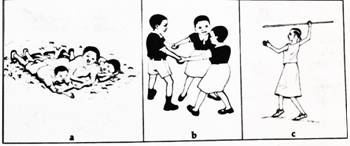
General space refers to the environment within which an individual operates It may be a small room, large field or cafeteria
Failure to understand personal or general space may result in hardships of some kind For example, limited personal space may lead to failure to perform an activity effectively Limited general space can lead to participants bumping into one another
Components of General Space
There are four components of general space:
- Levels
- Extensions
- Floor pathways
- Air patterns
- Levels refers to how close to the floor or how far away from the floor one is as he or she moves
- Extensions refers to locomotor actions. It describes the amount of space a movement pattern uses
- Floor pathway refers to how people move on the floor
- Air patterns refers to aerial directions as in netball, volleyball and javelin
NB, Personal space is one’s area of influence or direct control. It is also called kinesphere
It depends on a number of factors such as size of the person and the type of activity being done
IMPORTANCE OF GENERAL AND PERSONAL SPACE
- activities are done properly
- there is free body movement
- accidents that happen during performance of activities are reduced
FACTORS THAT DETERMINE GENERAL AND PERSONAL SPACE
- the type of activities to be done
- the size of the area to be used for activities
- the body size of the participants
- the number of participants involved in the activities
Artistic Activities within Personal and General Space
- Dancing
- Drawing
- Carving
- Sculpturing
- Skiing
- Jumping
- Swimming
- Running
- Jabbing in boxing
ACTIVITIES THAT REQUIRE PERSONAL SPACE
- skipping individually
- head stand
- forward roll
- backward roll
- push ups
- jogging
- sewing
ACTIVITIES THAT REQUIRE GENERAL SPACE
- ball games
- field and track events
- nzamanzama
- javelin
- skipping in twos, threes and larger groups
HOW PERSONAL SPACE CAN BE CREATED
- stretching out the arms outwards and then turning around on the same spot while swinging the arms
- stretching out arms in different directions without touching anything or anybody
OCCASIONS WHEN THE SOCIETY DOES NOT FOLLOW RULES OF PERSONAL SPACE
- wedding ceremonies
- funeral ceremonies
- meetings
- traditional dances
- installation of chiefs
The term ‘artistic ‘refers to the creativity, beauty and excellence in doing an activity, be it physical or non- physical.
BODY MOVEMENTS
Movements occur always in everyday life.
Most of the daily activities that we do require body movements. For example; cooking and sweeping. Body movements may also occur in response to a stimulus.
Body Movements in Response to Rhythms
The rhythm is a combination of different lengths of sounds and silences.
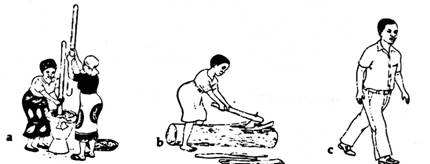
Examples of Rhythmic Activities in Everyday Life
- Heart beating
- Clock ticking
- Walking
- Talking
- Running
- Drawing
- Singing songs
- Pounding
- Playing instruments
- Carving wood
- Digging
Sounds and silences can be presented by symbols called musical notes. There are 5 commonly used notes:
- Whole note
it is oval in shape and has a white note head
- Half note
it is made of a white head and a stem
- Quarter note
it has a black head and a stem
- Eighth note
it has a black head, a stem and a flag
- Sixteenth note
it has a black head, a stem and two flags Sounds are also known as pitches.
Silences are also known as rest. Beat is also called pulse.
Musical notes have British and American names.

Rest signs and their names

TIME SIGNATURES
A time signature is a set of two numbers at the beginning of a rhythm.
![]()
![]() It is written as a fraction such as 6/8
It is written as a fraction such as 6/8
The top number shows the number of beats or counts in a bar/measure.
The bottom number shows the name of the musical note that is getting one beat or count.
The most commonly used time signature is 4/4 because it is easy to understand and learn.
STAFF NOTATION
The notation of music consists of staffs, clefs, meter or time signature, key signatures and notes of various times which indicate the relative duration of pitches.
Musical notation, therefore, comprises a set of terms and symbols for musical meanings.
- The staff/stave
This refers to a set of five lines and four spaces on which musical symbols are written to give a melody or a song.
Sometimes when writing music you may need additional lines below or above the staff. Such lines are called ‘ledger lines’. They indicate pitches above or below a staff.
- Letter names
The five lines and four spaces have letter names which do not change. The letters are A B C D E F G.
- G and F clefs
These are symbols allocated at the beginning of the staff, on the left end. G clef or Treble clef identifies the second line from the bottom as line G. G or Treble clef staff is used for soprano and alto voices in choral music.
The ‘F’ clef or ‘Bass’ clef establishes the location of F in the fourth line of the staff. F clef staff is used for tenor and bass voices.
- Bar lines
These are vertical lines on the staff which divide the staff into parts containing equal number of beats.
- Bar/measure
This is the space between bar lines and containing specified number of beats.
- Octave
This is a distance that covers eight musical notes, with the first note being equal in tone to the eighth note, however, lower in pitch to the eighth.
- Sol-fa syllables
These are the pitch names: DO RE MI FA SO LA TI DO
- Transpose
It means changing a piece of music from one key to another. For example, from C to F or G or vice versa.
There are various reasons for transposing a piece of music.
The following are some of the reasons:
- when a choir wishes to sing a higher or lower key so as to assist either adolescent boys’ or men’s voices to sing comfortably.
- When a singer himself or herself wants to sing a song in a higher or lower key comfortably.
- Key signature
This identifies which pitch is do
It is shown on the staff with sharps or flats.
Here are some examples of keys

- Scale
This is the arrangement of notes usually of the same totality, either in ascending or descending order.
Two examples are:-
- Diatonic scale
This includes eight pitches in major or minor scales. For example, do re mi fa so ra ti do
- Pentatonic scale
This includes only five pitches in major or minor scale (the fourth and seventh pitches are left out).
For example; do re mi so la do
The terms and signs are shown in the staffs as below:-
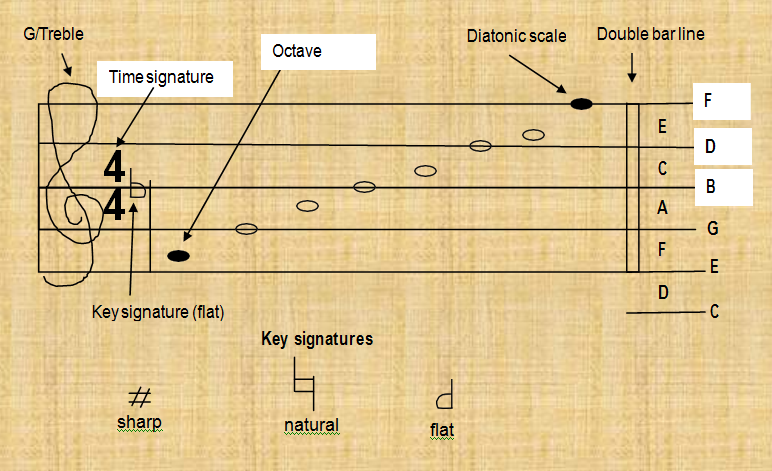
A DOTTED NOTE
A dot takes half the value of any note or rest that it is attached to.
If the value of a quarter note is equal to 1 beat, then a dotted note is equal to 1 beat plus half one beat, so the total value is one and a half beats.
Examples


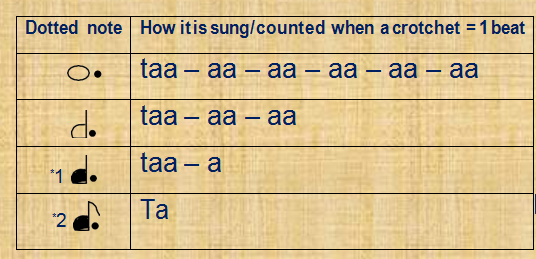
- would normally be combined with an eighth note to produce a 2 beat duration. For example;

- would normally be combined with a semiquaver to produce a 1 beat duration. For example;
BEAMING NOTES
A beaming note is a line which is used to join two or more notes together.
The number of beams or lines one uses to join the notes will tell the number of flags each one of the joined note has.
For example:-

Rhythm patterns can be performed by:-
- Clapping hands
- Tapping on the table
- Playing percussion instruments
- Walking according to rhythm patterns
MUSICAL TERMS
- Beat = equal division of sound or time
- Rhythm = unequal division of sound or time
- Tempo = speed of a song
- Dynamics = loudness or softness of a song
- Unison = to sing in one voice
- Attack = to start singing together
- A staff (stave) = a set of five parallel lines with four spaces on which music notes are written
- Measure/bar = a space between two bar lines
- Bar = any of the sections of equal value in time into which a piece of music is divided and the notes in it
- Bar lines = lines written on the staff before and after a measure
- Double bar lines = it is a full stop in music
- Ledger lines = these are extended (extra) lines on a staff
- Treble (G) clef = it is a symbol written at the beginning of a staff
- Key signature = it is a starting pitch of a song
- Music = the arrangement of sounds in pleasing sequence or combination to be sung or played on instruments
- Time signature = it is a symbol which looks like a fraction. The top number represents the number of beats in a measure. The bottom number indicates the type of a note which gets a beat. For example

- Clef = a symbol at the beginning of a line of printed music (or stave) showing the pitch of the notes on it
- Pitch = the quality of a musical note, a voice, et cetera, especially how high or low it is
- Tone = any one of the five larger intervals between one note and the next which, together with two semitones, form an octave
- Semitone (half tone) = half of a tone on a musical scale, for example the distance between C an C# or between E and F
- Octave = the difference or space between the first and the last in a series of eight notes on a musical scale
- Note = a single sound of a certain pitch and length, made by the voice or a musical instrument
- Note = a sign used to represent such a sound in written or printed music
- Note = any one of the keys of a piano, et cetera
- Slur = the mark
 or
or  used to show that two or more notes are to be played or sung smoothly and without a break
used to show that two or more notes are to be played or sung smoothly and without a break - Slur = to play or sing musical notes so that each one runs smoothly to the next
- Semibreve (whole note) = the longest written musical note in common use equal to two minims in length
- Minim = a note that last half as long as semibreve
- Crotchet = a note equal to half a minim
- Quaver = a note in music that last half as long as a crotchet
- Tie (in written music) = a curved line over two notes of the same pitch that are to be played or sung as one
- Percussion = musical instruments that are played by striking, beating or tapping with a stick, et cetera, for example, drums
- Melody = a piece of music or a song with a clear or a single tune
- Melody = the arrangement of musical notes in a pleasant or ordered way
- Sharp (n) = a note raised by one semitone or the symbol used
- Natural (adj) = neither sharp nor flat e.g. B natural
- Sharp (adj) = above normal or correct pitch
- Flat (adj) = (used following the name of a note) half a note lower than the specified note. B flat is a semitone below B
MIRRORING
Mirroring is the act of copying actions, words, or expressions of another person
It is a commonly used technique in physical activities intended to demonstrate a physical movement: a new dance step, a lay-up in basketball, a tennis serve, including running activities.

SOME MIRRORING GAMES
- Netball
- Football
- Handball
- Table tennis
- Basketball
- Lawn tennis
- Baseball
- Squash
- Chipako
- Mbalame zoyera
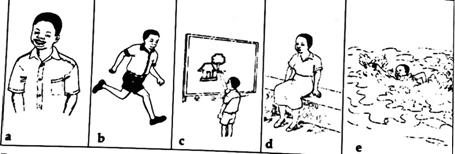
MIRRORING AEROBICS
Aerobics are physical exercises done following music Aerobics is a great medium to develop fitness
Types of Aerobics
- High impact aerobics
This involves a lot of jumping
- Low impact aerobics
This does not involve jumping, but always, one foot has contact with the floor
- Step aerobics
This uses stepping up and down from the platform
- Tai bo
This uses kicks and punches
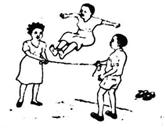
Aerobics is different from dance, because the aim of aerobics is to improve fitness while the aim of dance is to develop creativity.
NB. Aerobics is vigorous physical exercises done in order to increase the amount of oxygen taken into the body.
CONVEYING CULTURAL MESSAGES Garments Conveying Cultural Messages
The different attire that people wear may have a meaning for the specific occasion or function.For example, in Malawi, the Ngoni are fond of wearing their traditional attire of animal skins and shields to symbolise that they are warriors.
During most weddings, the bride wears white attire to symbolise purity.
During funerals, widows usually wear black attire during the entire mourning period to symbolise sorrow.
During the biblical times, the kings and officials wore sackcloth when something went wrong or when calamity fell on the land.
Sounds Used to Convey Messages
Some sounds have cultural meanings.
These sounds can be those produced during certain functions and occasions which are understood by the people who share the same culture.
For example:-
- Whistle blowing
- Drum beating
- Mouth whistling
- Bell ringing
- Singing
Posture and Body Movements
Cultural values can be manifested in many different ways besides attire and dances. There are certain postures and movements which portray cultural meanings.
For example, when crossing with elders, most cultures recommend the younger one takes off the hat temporarily as a sign of respect.
There are also times when some people clap hands gently and softly when crossing with an elderly person.
Some postures and body movements are squatting or kneeling when receiving or giving items to the elders.
Cultural Dances
Malawi has many cultural dances that have cultural importance for every cultural setting.
Among the well-known dances are Gulewamkulu among the Chewa, Chioda among the Nkhonde, Vimbuza among the Tumbuka, Likwata among the Sena and Jiri among the Lomwe.
IMPORTANCE OF TRADITIONAL DANCES AND SONGS
- They provide enjoyment to both spectators and performers
- They help to preserve culture
- They promote creative thinking and imagination
- They act as a source of income
- They communicate messages to people
- They depict one’s culture in society.
SOME TRADITIONAL DANCES PERFORMED IN THE REGIONS OF MALAWI
northern region |
central region |
southern region |
malipenga ingoma mbotosya indingala mwinoghe vimbuza chilimika |
chimtali malipenga gulewamkulu njedza chisamba chiterera mganda ngoma msindo ligubo |
beni masewe tchopa likhuba likwata mbwidza manganje utse mchomanga jiri |
- MULTI-CULTURAL PERFORMANCE
Artistic Activities from Various Cultures in Malawi
Multi-cultural performances are performances from different cultures.
Malawi has different ethnic groups like the Chewa, Ngoni, Tumbuka, Lomwe and Sena. Each of these ethnic groups has its own cultural performances.
These cultural performances have any aspects that are similar and different.
These aspects include the attire, instruments used in performances, organisation of cultural performances and the type of performances.
The cultural practices (performances) serve as an identity for a particular tribe or ethnic group. Malawi has different cultural practices.
These include folk dances and songs.
A folk dance is a recreational or ceremonial dance that is usually performed by members of the community.
For some tribe, a dance could be a form of a ritual.
They believe that a certain dance can make the rain fall, improve harvest and/or awaken the spirits of the dead.
Attire for Artistic performance
In different performances such as in drama, dance or choir, performers wear appropriate attire to suit the performance.
Attire makes the performers look smart and coordinated.
DESIGNING AND CONSTRUCTION
Musical Instruments Based on Foreign Models
Materials for making musical instruments:-
- pieces of string
- pieces of wire
- nails
- tins
- hammers
- knives
- metal sheets
- adzes
- hides
- wood
- plastic pipes
- plastic papers
Examples of Foreign Musical Instruments
- guitars
- banjos
- drums
- flutes
PROCEDURE FOR MAKING A BANJO
The following is the procedure for making a banjo:
- cut a piece of wood about 0.5m long
- carve the wood into the shape as shown below
![]()
- make four holes on the flat end of the wood using a piece of a hot metal as shown below
![]()
- carve four pieces of wood, flat on one end and round on the other end to be used as tuning knobs
- cut a slit on the round end of the tuning knobs for tying the length of string
![]()
- cut a small piece of wood with four grooves to act as a bridge
![]()
- cut two holes on a tin: one for the wood and the other for sound to enter
![]()
- insert into the tin the wooden handle
![]()
- cut a metal sheet from a tin and bore four holes for the lengths of string and two holes for nailing
![]()
- nail the metal sheet to the back of the tin together with the end of the wooden handle as shown below
![]()
- tie four lengths of string to the metal sheet then tie the other end of the lengths of string to the tuning knobs fixed at the head of the wooden handle
- put a bridge between the hole on the tin and the metal sheet
![]()
- tune the knobs to tighten the string to the required pitch
- test the instrument by plucking the length of the string
- decorate the banjo as required
Garments and Artistic Items Based on Modern Styles
The art of constructing garments is useful because one can make one’s own clothes and those of others.
Garments are different types of clothing.
These garments include:
- Pairs of trousers
- Pairs of shorts
- Skirts
- Blouses
- Petticoats
- Pairs of socks
- Dresses
IMPORTANCE OF MAKING YOUR OWN GARMENTS
- it is cheaper to make your own garments than buying them
- it can be a source of income when the garments made are sold
- it improves the skills of making different designs of garments
- the one with skills in making garments can help other members of the community learn the skills of making garment free or at a nominal fee
Factors to Consider in Garment Construction
- knowing what is to be made
- size of the wearer
- the amount of fabric to be used
- the designs that are in fashion
Advantages of Taking Body Measurements
- it helps one to come up with the required size of the garment which fits well
- it also minimises wastage of material
PAPER PATTERNS
Paper patterns are pieces of paper cut out to the shape of parts of a garment to be made. They can be altered to suit body size.
Pattern Markings
These are markings with particular information and instructions on:-
- the number of pieces to be cut
- the pieces to be joined together
- how to place pattern pieces on the fabric
- where to stitch
Pattern Markings and Their Meanings
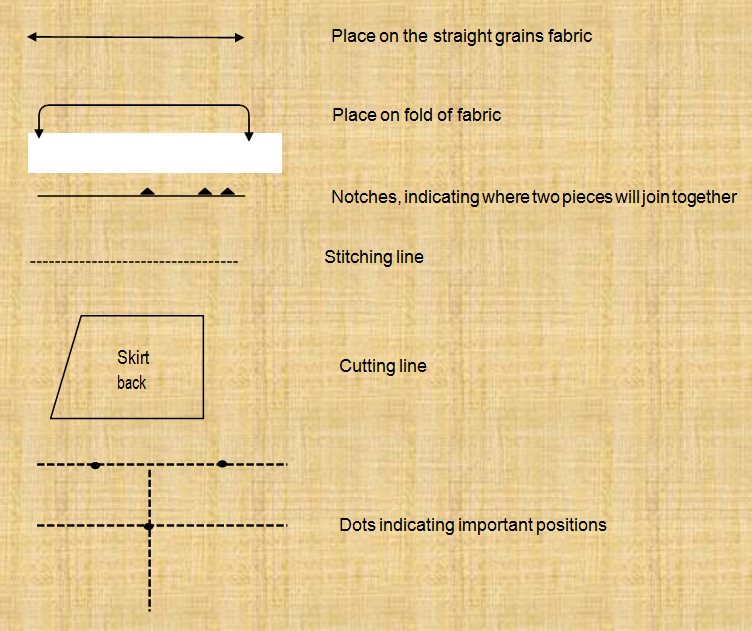
Materials Required for Making Garments
- pieces of fabric
- paper patterns
- pair of scissors
- tape measures
- pressing irons
- a clean table or mat
- pins
- sewing needle
- thread
- pieces of paper
- elastic
LAYING PATTERN PIECES ON THE FABRIC AND PINNING
- always have your pattern and fabric smoothed flat with a pressing iron to remove creases
- press with iron if they are not smooth
- fold the fabric according to the pattern layout before laying pattern pieces
- lay larger pieces first, then place smaller ones last
- keep the fabric flat on the table while pinning so that the pattern does not slip out of position
- pin at intervals along all straight and diagonal edges into each corner
The following diagram shows a pattern layout for a petticoat
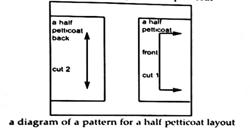
CUTTING OUT
- make sure that all pattern pieces are laid out and pinned on the fabric
- cut out all pieces using a sharp pair of scissors along the edge of the pattern
- cut using long, even strokes in order to produce smooth edges. Do not lift the fabric when cutting
- always cut away from yourself and never towards yourself with one hand supporting the fabric
- after cutting out each section fold it and put it aside neatly
MAKING A SPORTS SHORTS

Cutting out Requirements
- 1 metre cotton fabric
- pins
- paper patterns
- a pair of scissors
Layout
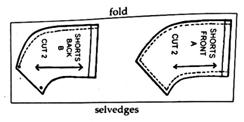
Assembling the shorts
- using the open seam, join the two front and the two back pieces together


- clip the front and back seams on curved edge


- neaten the seams using loop stitch
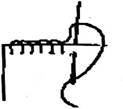
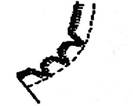
- join the back and front of the shorts with the French seam at the side

- cut crossway strips from left over fabric. Join strips and attach at lower edges an sides of both legs

- join the crotch seam and neaten with running stitches
- fold over a 5cm hem on the waistline of shorts, tack and back stitch. Work running stitches on the upper edge of the waistline hem

- make an opening the wrong side for inserting elastic/chord. Neaten the sides of the opening using loop stitches

- press and display the finished product
Macrame
Macrame is the art of knotting (tying strings or fibres) to produce decorative and functional articles.
Two Basic Knots in Macrame
- half knot (or half hitch)
- flat knot (the reef hitch or weaver’s knot)
Produce from Macrame
- belts
- book bags
- flower vase holders
- flower pot holders
- wall hangings
How to make a macrame pot holder
- prepare enough string from sisal fibre
- cut two long lengths of string and six short ones, half the length of the long ones as shown below
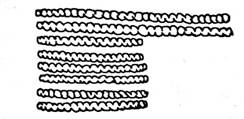
- find the mid points of the eight length of string
- put the midpoint together and tie the lengths of string at the common mid-point

- using the two long lengths of string on either side of the mid-point, make flat knots with the short lengths of string as shown below
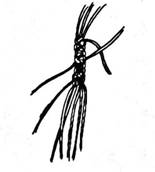
- make the flat knots 15cm on either side of the mid-point
- remove the string marking the mid-point
- divide the lengths of string into four parts with four of them on each part
- using the four lengths of string on each part, make flat knots for a lengths of about 10cm long as shown below
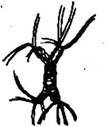
- place the four branches of the knotted length of string around the mouth of the pot. Make flat knots to tighten the branches around the mouth of the pot, letting the loose length run down the sides of the pot
- make flat knots using four lengths of string alternately as you work down the sides of the pot
- continue with this process to the bottom of the pot
- tie the lengths of string at the bottom of the pot
- trim the lengths of string to equal size
A macrame potholder

How to make a simple macram wall hanging
wall hanging
Preparation
- cut between cords or string into suitable lengths, e.g. 30cm
- then cut between 20 and 30 pieces of string of 1m long each

- make flat knots, three lines; alternate flat knot, six lines; make a half hitch, another six lines and continue with flat knots
- make half any number of lines for the required lengths
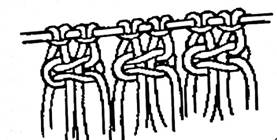
- close by making flat knots and leave the pieces of string hanging. Make sure you cut to the required length
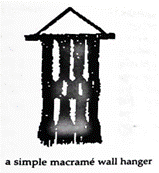
the flat knot can be alternated to appear differently
Three stages of working a flat knot
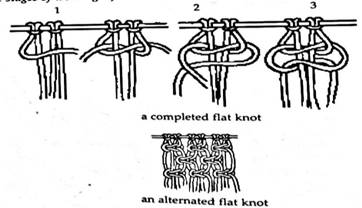
Materials for Making Macrame
Items
- knives
- hoes
- sisal fibre
- tree bark fibre
- banana sheath
- mlulu
- chilambe
- namgoneka
Marketing/Advertising the Artworks
- word of mouth
- newspapers
- radio
- television
- internet
- posters
Ways of Storing Artwork
- keep the artwork away from heat sources such as fireplaces and heaters
- cover the artwork with a clean piece of cloth
- place the artwork on acid free boards
- keep artwork away from direct sunlight
- avoid storing artwork on concrete floors or walls
- avoid storing artwork in attics and basements
Drama Based on Foreign Plays
Drama is acting out situations in order to inform, entertain and educate the audience.
Types of Plays
- tragedy
- comedy
- Tragedy is a play with a sad ending.
- Comedy is a play with a happy ending.
When dramatising such plays, the actors and actresses should appear real. Firstly, this can be achieved through the use of visual aspects such as:-
- scenery
- costume
- props
- lighting
- make up
Secondly, this can be achieved through sound effects such as:-
- physical (vocal, feet, hands, coughs, sneezes)
- percussions (drums, chimes, xylophones)
The purpose of this is to make the audience see and hear the play.
PERFORMING DANCES MUSICAL INSTRUMENTS
Most Malawian societies use musical instruments.
NAMING MUSICAL INSTRUMENTS
Some of the musical instruments are:
- Drums
- Horn
- Xylophones
- Flute
- Guitar
- banjo
- rattles
IMPORTANCE OF MUSICAL INSTRUMENTS
- they complement human voice
- they add harmony in music
- they reflect the cultural history of an ethnic group
- they attract attentiveness and concentration of the musical players and listeners
- they foster self expression
- they add beauty in music
- they promote discipline
- they promote social skills
- they boost listening skills
- they relieve stress
- they accompany songs and dances
- they are used to convey different messages
- they indicate the speed at which one can dance and when to change step
MAJOR DIFFERENCES BETWEEN TRADITIONAL AND MODERN MUSICAL INSTRUMENTS
- traditional musical instruments do not use electricity to play while most modern musical instruments use electricity to play
- traditional musical instruments are made locally while most modern musical instruments are imported from other countries
- traditional musical instruments are cheap while modern musical instruments are expensive to buy
- amount of materials used
- time spent in making the musical instruments
- attractiveness of the finished musical instruments
- age group meant for the musical instruments
- availability of the musical instruments
- availability of the musical instruments
- quality of the musical instruments
- cost of materials, if the materials for making the musical instruments were bought
- demand for the musical instruments
- tuned musical instruments
- untuned musical instruments
- guitar
- piano
- accordion
- flute
- woodblocks
- rasp (nkhwende)
- maracas (maseche)
- badza
- drum
- rattles
- mangolongondo (xylophones)
- horn (chitoliro)/bat
- panpipe
- kalimba
- mkangala
- bangwe/mbila
- plucking
- beating
- blowing
- stroking
- pressing
- shaking
- clapping hands
- snapping fingers
- slapping body parts such as thighs, chest and cheeks
- tapping feet on the floor
- whistling
- ululating
- Clicking the tongue against the roof of the mouth The Malawian society performs a lot of cultural dances.
- Festivals
- Funeral ceremonies
- Weddings
- Installation of chiefs
- Initiation ceremonies
- they promote identity of an ethnic group
- they help in disseminating important messages
- they promote one’s culture
- they promote oneness
- they promote obedience
- they promote respect
- certain dances are believed to make rain fall, improve the harvest or awaken the spirits of the dead
- Respect
- Obedience
- Tolerance
- Modesty
- Patriotism
- Love
- Reliability
- Honour
- Oneness
- Trust
- CHILIMIKA
- Festivals
- Funeral ceremonies
- Weddings
- Installation of chiefs
- Initiation ceremonies
- Gulewamkulu
- Beni
- Tchopa
- Chinamwali
- Chitelera
- Chisamba
- They look at them as outdated
- They look at them as boring
- They look at them as out of fashion
- Local dances can lose their cultural significance
- Cultural values can be diluted
- The youth can shun local dances altogether
- Local dances can lose their identity
- Reggae
- Kwasakwasa
- Ndombolo
- Kwaito
- Digong
- Kwasakwasa involves a lot of waist wriggling
- Kwaito has flexible and quick foot movements.
- Should look attractive
- Should be coloured
- Words should be bold
- Information should be brief
- Information should be clear
- They can be used for advertising the businesses
- Self-made posters can be sold to generate income
- They are cheap to produce locally
- Chart paper
- Lead pencils
- Coloured pencils
- Crayons
- Marker pens
- Paint brushes
- Rubbers
- Local paints
- Old cement bags
- HIV and AIDS
- Environmental degradation
- Pollution
- Corruption
- Violation of human rights
- Democracy
- Child marriages
- Child abuse
- Wife buttering
- Prevention of HIV and AIDS
- Wanton cutting down of trees
- Use of dangerous chemicals
- Should look attractive
- Should be coloured
- Words should be bold
- Information should be brief
- Information should be clear
- Can be used for advertising your business
- Self-made posters can be sold to generate income
- It is cheap to produce locally
- Chart paper
- Lead pencils
- Coloured pencils
- Crayons
- Marker pens
- Paint brushes
- Rubbers
- Local paints
- Old cement bags
- Have a plain sheet of paper or cement bag or white polythene sack
- Draw a margin throughout along the length and breadth of the paper
- Make a sketch of what you want to draw using pencil
- Use different colours to mark the outline
- Write the heading of the poster inside the margin
- Wooden spoon
- Wooden cooking stick
- Axe handle
- Hoe handle
- Statue
- Wood
- Soapstone
- Glue
- Glass paper
- Water paper
- Axes
- Panga knives
- Machete
- Saws
- Gouges
- Chisels
- Rasps
- Mallets
- Scrapers
- Adzes
- Stones
- Hammers
- Abstract carvings
- Stylish carvings
- Naturalistic carvings
- Abstract carvings
- Stylish carvings
- Naturalistic carvings
- Glass
- Pieces of wire
- Cartons
- Sisal
- clay soil
- grass
- papers
- aeroplanes
- cars
- animals
- people
- train
- surrounding
- house
- check weave
- twill weave
- palm leaves
- bamboo leaves
- pieces of reed
- sisal
- grass
- creeping stems
- knives
- razor blades
- needles
- mats
- baskets
- chairs
- brooms
- shopping bags
- school bags
- sisal
- yarn/thread
- cloth
- needles
- bamboo sticks
- bicycle spokes
- knit stitch
- purl stitch
- garter stitch
- stocking stitch
- moss stitch
- rib stitch
- belts
- scarfs
- baby blankets
- stockings
- pencil bags
- cardigans
- inadequate resources
- lack of exposure
- inability to market products
- jealousy
- using renewable resources
- buying resources
- replacing used resources
- inviting people through advertising
- improving quality of products
- consulting and talking to interested persons
- Development of skills in self expression
- Promoting social interaction and cooperation
- They allow for deep self expression
- Development of self-reliance and collaboration
- Development of reasoning and creative thinking
- Development of motivation, concentration and teamwork
- Promoting interpersonal skills
- Being awarded with some prizes after performing
- Drama
- Dancing
- Sports
- Singing
- Poetry
- Comedies
- Plays
- Open the mouth wide enough to insert two fingers side by side in the mouth
- Take a deep breath and say or sing oooooo, uuuuuuuu and aaaaaaa – repeat this several times.
- The musical studio
- In the homes
- Football
- Netball
- Volleyball
- Basketball
- Coaching
- Tennis
- Boxing
- Athletics
- Football
- Punting
- Scoring
- Attacking
- Defending
- Marking
- Dribbling
- Heading
- Agility
- Jumping
- shooting
- Balancing
- Communication
- Positioning
- Saving (goalkeeper)
- Throwing
- Controlling the ball
- Passing
- Running
- Decision making
- Leadership
- Composure
- Vision
- Intelligence
- Resistance
- Power
- Strength
- Stamina
- Sprinting
- Pace
- Netball
- Attacking
- Defending
- Catching
- Throwing
- Scoring
- Dodging
- Shooting
- Volleyball
- Serving
- Blocking
- Digging
- Passing
- Spiking
- Basketball
- Dodging
- Dribbling
- Shooting
- Boxing
- Jabbing
- Circles
- Ovals
- Rectangles
- Squares
- Parallelograms
- Quadrilaterals
- Eggs
- Boxes
- Tables
- Houses
- Animals
- Human figures
- Dice
- Cubes
- Quality
- Quantity
- Durability
- Demand
- Supply
- Cloth/fabric
- Sewing needle
- Sewing thread
- Pairs of scissors
- Razor blades
- The waist
- Hips
- Chest
- Thighs
- Calves
- Upper arm
- Shoulder
- It determines the size of the fabric to be bought
- It also tells the size of the costume to be made
- It avoids wastages of materials
- It avoids wastage of money
- Spears
- Bows
- Arrows
- Clubs
- Catapults
- Guns
- Tattooing
- Burning
- Stamping
- Tattooing
- Incising or engraving
- Stamping or impressing
- Polishing or burning
- Colouring or staining
- Coiling
- Sadness
- Happiness
- Hunger
- Sorrow
- Farewell
- Invitation
- Denial
- Consent/agreement
- Welcome
- Pencils
- Papers
- Charts
- Paint
- Crayons
- Sisal fibre
- Reed
- Palm leaves
- Pieces of bamboo
- Bark fibre
- Pieces of string
- Pieces of cloth
- Animal skin
- Strips from old tyres
- Baskets
- Table mats
- Door mats
- Ropes/strings
- Mesh hair
- Bags
- Take two strands.
- Using the second strand, coil one end in the middle of the strand
- Twist the right strand in between the other strands, then the left strand in between the other strands to make the rope.
- Doing warm ups and cool downs
- Thrower should always be in front of others
- Clear the area where the activity will be done
- Always use equipment that is in good condition
- Store and keep equipment safely after use to prevent wrong use
- Proper handling of sharp tools, for example, needles
- Wearing a thimble when sewing
- Proper sharpening of tools
- Splitting and processing bamboos with care in weaving
- Referee should control the game
- Referee should give penalties for bad play
- Plant grass on bare ground
- Remove anthills and stones from the ground
- Fill ditches and holes on the ground
- Cut all grass for the balls to run smoothly
- Goalkeepers wearing protective wear
- Make the ground flat
- Put pins or needles on a pin cushion
- Point the needle towards your own body when sewing
- Cut away from others
- Handle scissors or razor blades properly
- Put pressing iron on a stand after every pressing
- Remove charcoal after use
- Switch off and plug off the electric iron after use
- Proper storage
- All races of one lap for example: 100m, 200m should be run in lanes
- Runners should be well spaced and limited in number
- Obey the rules
- Breathe through the nose when running
- Do cool down activities
- Sharpen equipment away from your body
- Place tools in safe places
- Hold tools firmly when sharpening them
- Avoid cutting close to where you are holding the object being carved
- Walk with the javelin in vertical position to the playing field
- Put a cork or a protective cloth on both ends of the javelin when not in use
- Adequate preparation
- Use lanes when running
- Ensure learners (runners) are well spaced in races of more than one lap
- Count all learners (runners) before and after long runs
- Provide transport behind the runners in long distance running
- Observe rules of the game
- Umpires should ensure fair play
- Playing field should be dry
- Use approved balls
- Avoid treading on the ball
- Spikes should be empty part of the court
- Cut grass on the pitch
- Provide goalkeepers with protective clothing
- Use sticks that are in good condition
- Avoid dangerous play
- Referees should be strict in the game
- Cut grass on the field of play
- Ensure the field is free of risks
- Use clothing that allows free movement
- Proper supervision of the activities
- Give activities according to the age of the learners
- It ensures that the articles are made for a purpose and benefit
- It increases profit from the sales of the articles made
- Carrying out a research (to identify potential customers)
- Costing the items
- Displaying the items
- Advertising
- Selling
- To understand what people’s likes are
- To discover where particular artefacts are popular
- To convince people that they will not regret after buying the artefacts
- Carrying out a research
- Costing the artefacts
- Displaying them
- Advertising them
- MIE, Standard 7 Expressive Arts Teachers’ guide (2008) MOEST,
- IPTE through ODL Expressive Arts Module 1 MOEST,
- IPTE through Conventional Expressive Arts Book Advanced Oxford Dictionary
- Wikipedia:WikiAfrican/incubator/stubs/dance_in_Malawi
- www.ezstoragenow.com/how-to-properlystoreartwork
- www.managementstudy.com/objectives-importance-of-advertising
FACTORS TO CONSIDER WHEN COSTING MUSICAL INSTRUMENTS
TYPES OF MUSICAL INSTRUMENTS
There are two main types of musical instruments
These are:
Tuned musical instruments such as the banjo produce different pitches
More examples of tuned instruments:
Untuned musical instruments such as chisekese produce a fixed pitch. More examples of untuned musical instruments:
Musical instruments can be sold and generate income.
However, the making of musical instruments can have a negative impact on the environment.
The excessive use of trees without replacing them can lead to deforestation, siltation in rivers and degradation of the land (land degradation).
Therefore there is need to replace the natural resources like trees to ensure sustainability of the resources.
How Musical Instruments are Played
Musical instruments can be played by:

The other group of musical instruments is called body percussion. Body percussion is the use of the body in various ways
The body can produce sound by:
Occasions When Dances Are Performed
Significance of the Dances
LOCAL DANCES
Local dances are traditional dances that are performed in the communities.
Cultural values depicted in traditional dances
LOCAL DANCES IN MALAWI
Chilimika means year
This dance is performed mostly by young Tonga women of Nkhatabay District.
At each New Year's Day, young men and women congregate at the village arena to entertain the village with Chilimika.
This dance is an imitation of Malipenga which is mostly performed by men.
GULE WAMKULU
Gulewamkulu is also known as "the Great Dance".
Gulewamkulu is performed at the request of the village headman on the occasion of funerals of village members, puberty initiations and the installation of chiefs.
It is performed by Chewa men.
LIKHUBA
Likhuba is a dance performed to cure psychological illness by women.
It is largely an acrobatic demonstration of male prowess by the Sena of Lower Shire. These days the dance is performed for entertainment.
TCHOPA/SOOPA
Tchopa or Soopa was originally performed by the Lomwe during tribal wars as well as sacrificial ceremonies when a calamity had struck.
Tchopa is popular in Thyolo, Mulanje and Chiradzulu Districts. It is mostly performed for entertainment.
UYENI
Uyeni is a Ngoni dance usually for girls who dance bare foot with their breasts exposed. It is mostly performed during the installation of chiefs.
MWINOGHE
In the Chisukwa dialect, the word mwinoghe literally means "let us enjoy ourselves thoroughly". Mwinoghe is an instrumental dance that is popular among people especially school children in Chitipa District of the Northern Region of Malawi.
It has been derived from a ceremonial dance of Karonga District called Indingala which was originally performed by men brandishing fly-whisks during either the enthrallment of a chief or feast over a dead marauding lion.
The main percussion instruments used in the dance are one big drum called Ing'ina and two small ones called Twana, but sometimes a whistle is used.
The dancers line up in two straight lines, boys on one side and an equal number of girls on the other, facing one another. While the girls continue dancing in a standing position with their hands raised up, the boys squat down wriggling and twisting their bodies, all to the rhythm of the instruments.
Mwinoghe is therefore a cerebration dance
MANGANJE
Manganje is an initiation dance performed by the Yao of Machinga, Mangochi, Zomba and Blantyre Districts.
It is performed at the initiation of boys.
Today Manganje is also performed for entertainment.
MALIPENGA
Malipenga is a modern dance for men.
Malipenga started in Nkhatabay District and spread all over the Northern Region of Malawi.
In the central region, Mganda, which is a variant of Malipenga is performed in Kasungu, Nkhotakota, Salima, Ntchisi, Dowa and Lilongwe Districts.
Occasions When Local Dances are Performed
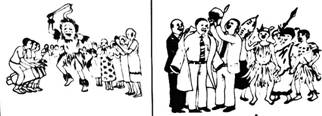
CONTEMPORARY DANCING STYLES
Most of the Malawian traditional dances have cultural values and a history.
However, most of Malawians, particularly the youth, do not participate in these cultural dances.
DANCES DEPICTING CULTURAL VALUES

Some dances that depict cultural values are as follows:
Reasons for Youth Not to Participate in Traditional Dances
Malawi is also flooded with a lot of contemporary dances.
However, traditional dancing styles can be combined with contemporary dancing styles to improve the performance.
The disadvantages of mixing traditional dancing styles with contemporary dancing styles are that:
Some Contemporary Dances
Contemporary Dancing Styles
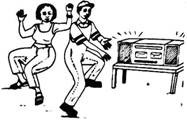
These foreign dancing styles have influenced the way people perform the local dances.
The people combine the foreign dancing styles with the original styles with the original styles to improve their performance.
SELF EXPRESSION THROUGH POSTERS, DANCES, SONGS AND PLAYS
Posters on Various Themes
Posters are useful in the dissemination of information on a cross-cutting issues
Qualities of Good Posters
Importance of Posters
Materials for Making Posters
CROSS-CUTTING ISSUES
Cross-cutting issues are challenges that affect many people and cause great concerns
Examples of Cross-Cutting Issues


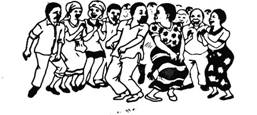
Dances on Cross–Cutting Issues
The school can perform dances where songs contain messages on issues concerned.
The dances and songs are a form of entertainment to draw people’s attention as they listen to messages.
Songs on Cross-Cutting Issues
Songs, like dances, play an important role in conveying messages on cross- cutting issues
Singing and dancing together offer entertainment to motivate the target audience while receiving messages by passed on
Plays on Cross-Cutting Issues
The messages on cross-cutting issues are easily passed on to an audience through plays.
A play is a form entertainment intended to attract the attention of the audience while the messages are passed on.
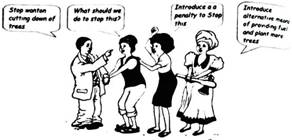
THEMES ON VARIOUS CROSS-CUTTING ISSUES
Some of the themes can be on:
ARTISTIC SKILLS AND MOVEMENTS
Most of the activities that we do require movements These movements require skills
A skill is a talent that an individual shows when doing something. Most of the skills that individuals have are either learned or inborn. There are various artistic activities that are popular these days These are known as contemporary artistic activities
The common examples of artistic activities are songs and dances.
Various materials found in the local environment can be used for artistic activities
Items for Artistic Activities
Every individual has skills that are either acquired or inborn.
Possessing these skills is very important because individuals that possess them often become successful in whatever they do.
The production of posters, carvings, models, woven items and knitted items require these skills.
Making Posters
Posters on Various Themes
Posters are useful in the dissemination of information on a cross-cutting issues
Qualities/characteristics of Good Posters
Importance of Posters
Materials for Making Posters
PROCEDURE FOR MAKING A POSTER
Carving Artistic Items
Materials for Carving
Forms of Carvings

Characteristics of each type of carvings
Abstract carving does not have a definite form
It can be interpreted differently by different people
Stylish carving has a definite form
However, some parts are exaggerated deliberately
For example, a carving of a person with a protruding chin
Naturalistic carving has a form which looks definite or real
Modelling

Materials for Modelling Various Items
Items that can be Modelled
Weaving
Weaving is the interlocking of warps and wefts.



The warp is the set of strands which are laid across the loom at the beginning of weaving.

The weft is the pattern of strands woven in and out of the warp.
Types of weave
Check weave
This interlocking follows a given pattern of:
Row 1: Over 1 under 1 over 1 under 1 – continue
Row 2: Under 1 over 1 under 1 over 1 – continue After line B repeat from line A to form a check weave.

Twill weave
Row 1: under 1 over 2 under 2 over 2 under 2
Row 2: over 2 under 2 over 2 under 2 over 2
Row 3: over 1 under 2 over 2 under 2 under 2
Row 4: under 2 over 2 under 2 over 2 under 2
After row 4, continue by repeating row 1. This produces a twilled or diagonal weave.

Materials for Weaving Various Artistic Items
Produce from weaving

![]()


Knitting

Materials for Knitting Various Artistic Items
Basic knitting stitches
There are two basic knitting stitches:
All patterns are formed based on variations of these two stitches
Patterns of Stitches
This stitch can be used in making knitted belt, scarfs or baby blankets
This stitch is often used to knit stockings and pencil bags
This stitch is a combination of knit and purl stitches done in the same row
This stitch forms the border of many knitted garments’ edges such as the sleeves, necklines and the edges
Knitting Abbreviations
K |
= |
knit |
P |
= |
purl |
Rep |
= |
repeat |
Sts |
= |
stitches |
Wfd |
= |
wool forward |
St |
= |
stocking stitch |
Alt |
= |
alternate/alternative |
Psso |
= |
pass slip stitch over |
Products Made from Knitting
CHALLENGES THAT ARTISTS FACE
SOLUTIONS TO THE CHALLENGES THAT ARTISTS FACE
CONTEMPORARY ARTISTIC ACTIVITIES
Contemporary means something which is modern, current or in fashion.
Music and dance are some of the activities that have examples of contemporary experiences. There are dancing styles which are popular in both religious and ordinary circles.
Some of the contemporary African music and dance styles include kwasakwasa, ndombolo, digong and kwaito.
Contemporary music and dancing styles that originated from outside Africa, but are performed in Malawi include hip hop, R and B and reggae. These are gradually becoming part of our culture because many of young people like them.
In the past, popular dancing styles included simanjemanje, sinjonjo and tsabatsaba from within Africa while break dance, twist and scanky were styles from the West. Some of these dancing styles are still popular such as break dance.
THE BENEFITS OF PERFORMING ARTISTIC ACTIVITIES
ARTISTIC ACTIVITIES THAT CAN BE PERFORMED FOR COMPETITION
SELF EXPRESSION
There are many ways in which individuals express feelings through music.
One most common feeling expressed through music is an expression of joy or happiness.
It is possible for the composer to create a mood of the song – to make it sound jovial or sad. There are symbols that one may use when composing song.
These are called music notations
Good and quality musical sound is a result of good voice production.
Good voice production comes through practice of a number of musical related exercise. There are many activities we can do continuously to develop good voice production Some of the exercises that one can do are as follows:
- This involves control of jaws rather than the lips alone.
Diction is the articulation of words clearly
When singing one conveys a message. Therefore, there is need to say the words clearly so that the message is clear.
RECORDING SONGS
Recording a song can be done at:
Recording a song should be done in an appropriate place or room that is free from noise and wind
Record the song several times to get the right quality that is required
The procedure for composing songs
Step 1 Think about the message you want to convey in the songs Step 2 Identify the target audience
Step 3 What mood of the song do you want to convey your message through? Step 4 Identify a tune for your song
Step 5 Find words to the tune of your song (consider things such a rhymes in your words of the time, just like in poetry)
Composing Instrumental Music
Composing instrumental music involves musical instrument without words. This can be done by playing one instrument or many instruments combined.
The most important factor to consider for instrumental music is to create room for each instrument to be heard clearly.
There has to be times where one instrument is played louder than the rest.
One can also use handclapping, tongue, clicking, finger snapping as musical instruments besides the drums and other musical instruments.
However avoid overcrowding the song with instruments.
Skills for Professional Sporting Careers
A skill can be defined as a way to do something

Identifying various sporting careers
Various Skills in sporting careers

PLAYS FOR THE PUBLIC PERFOMANCE
When writing plays for the public performance the playwright should consider the audience first. The target audience will determine the theme and characters to be in the play.
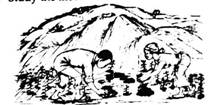
For example, if one is writing for the school going youth, the basic idea should suit the age and type of students.
Likewise when one is writing for the community, one should have a picture of what kind of community it is, what are its likes and dislikes, what are the people’s beliefs and educational levels
Therefore, factors to consider when writing a play for public performance are:
® Target audience
® People’s beliefs
® Educational levels
® Likes
® Dislikes
® Cultural background
® Age
Whatever audience you are writing for, ensure that there is a theme (the basic idea you want to pass), a realistic plot (story line) and characters (people in the play).
When acting out, make sure you create a conflict.
The audience should be kept in suspense up to the end, but towards the end the audience should see the climax and get resolutions of the climax.
A climax is the point of the story at which the interest is highest.
This comes somewhere near the end and after this there are resolutions.
Drawing Pictures for Sale
Drawing is a means of expressing and communicating one’s feelings. Drawing is an arrangement or organisation of lines to make basic shapes. The drawings may be two dimensional or three dimensional.

Examples of Two Dimensional Drawings

Examples of Three Dimensional Drawings

Some of these may be traced using paper, transparent plastic sheets and perforated picture outlines.

Three dimensional drawings can be formed by shading the two dimensional drawings. Shading makes them look solid.
Drawings or pictures for sale should look attractive.
In order to achieve this, painting or colouring is done to add beauty. After colouring, the items can be given costs, advertised and sold.
Factors to Consider When Costing
Importance of Advertising
® It helps to increase sales
® It helps producers to know their competitors and plan accordingly to meet up the level of competition
® It helps in making people aware of the new product
® It helps creating goodwill for the company and gains customer loyalty after reaching a mature age
® It helps educating people
® It helps people find the best products for themselves
ARTISTIC ACTIVITIES FOR ECONOMIC EMPOWERMENT
Activities such as making the costumes and drama performances can be a source of income.
The production of costumes for various activities requires the identification of suitable materials, taking of appropriate body measurements and cutting out of suitable patterns.
Materials for Making Different Costumes and Sports attire
Taking Body Measurements
Body measurements can be taken from:
Measure at your waist under the hip bone
Start at the hip level on one side, then capture the middle of the groin before wrapping around the opposite side
Wrap the tape high under the armpits around to the front of the chest
Measure at the highest point of the thigh, under the pubic bone
Measure at the thickest point of the calf, typically half way between the knee and the ankle
Wrap the tape measure around the biceps half way between the armpit and the fold of the elbow
Measure the shoulder line from the back
Importance of Taking Body Measurements
SELF EXPRESSION THROUGH ART
Expression and communication can be done in various ways.
It can be done through speaking, writing, gestures and artefacts.
The communication without speaking is called non-verbal communication.
Making Different Items
Different items can be done in different ways.

Making Hunting Tools
The following are tools for hunting:-
Some of the hunting tools are made by carving. For example, clubs
Decorating Items
The following are methods of decorating hunting tools:-
Clay work, like pots and flower pot holders can be decorated by:-
Body Shapes and Movements
Different body movements can convey specific messages.
For example. A person might use a wave rather than saying “hello”. Or nod their head in agreement, which may mean “yes”.
The body movements can be useful in expression and communication because they are a quick way to convey thoughts and feelings without speaking or writing.
The identification of the messages to be expressed and communicated by the body movements is important in every social setting.
This is so because it enhances cooperation and a caring spirit among the members of the community.
Feelings and Ideas which can be Expressed and Communicated through Body Movements
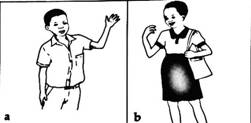
Drawing Pictures
Drawing is a means of expression and communication which uses visual images to pass on information to the reader.
The drawings can contain a lot of information as much as writing. Pictures convey messages quicker than writing.
Materials for Drawing Pictures
ARTISTIC PERFORMANCE
Items to Meet Personal and Community Needs
Different people need different items in their lives.
Some of the items can be purchased from shops while others can be made.
Producing your own items can help you to cut down the costs which you could have made in the course of purchasing the items (save money)
On the other hand, producing items to meet other people’s needs becomes a source of income to the producer.
Some of the items that one can make are garments, household items and safety equipment.

Plaiting different Items
Plaiting is weaving strands of hair, rope and so forth together to make a plait. Plaiting is the interlocking of three or more strands.
Three strands can be used for making ropes for table mats or tying goats and mesh for hair. More strands can be used for making mats.
Resources Required for Plaiting Different Items
Produce from Plaiting
Procedure for plaiting strings and ropes
RISKS IN USING EQUIPMENT
The table below shows sources of risks in various sporting and artistic activities
ACTIVITY |
SOURCE OF RISKS |
Weaving |
Equipment such as bamboos and chisongole |
Knitting |
Equipment such as knitting needles |
Sewing |
Equipment such as sewing needles and pressing iron |
Carving |
Tools such as adzes (kasemasema) |
Athletics: track events (running activities. For example, relay race and cross country) |
Small running lanes, stones, litter, sharp objects, bricks, rough surfaces, lack of warm up and cool down activities |
Athletics (throwing events) for example, javelin, discus, shot put |
Poor condition of equipment, poor handling of equipment and slippery and rough surfaces |
Ball games |
Sports surfaces in poor conditions, lack of warm up and cool down activities, wrong pressure and size of balls, poor condition of balls |
Strategies for Reducing Risks
The table below shows strategies that can be used to reduce risks
ACTIVITY |
RISKS |
STRATEGY THAT CAN BE USED TO REDUCE RISKS |
Playing ball games |
Getting fractures, cuts and scratches |
|
Ball hitting players |
||
Players hitting each other |
- Strictly observe the rules of the game |
|
Sewing |
Needle pricking ones finger |
- Use a thimble to protect the middle finger when sewing |
Needle pins piercing others or oneself |
||
Cutting oneself or others |
||
Burning oneself or others |
||
Athletics |
Hitting one another due to bunching (many people being together without enough personal and general space) |
|
Collapsing |
||
Carving |
Getting cuts or tears |
The table below shows some of safe practices in different activities
ACTIVITY |
SAFE PRACTICES |
Javelin |
|
Discus |
- Use discus without cracks and worn out reams |
The shot |
- Hold the shot with a firm grip |
Jumping events |
- Have a soft landing area |
Athletics |
|
Basketball |
- Minimise contacts among players |
Netball |
|
Volleyball |
|
Field hockey |
|
Football (soccer) |
|
Gymnastics |
|
Singing |
-Avoid singing on top of ones voice for a long time to avoid straining vocal chords which may lead to bruises |
Dancing |
-Dances that are vigorous require enough training to avoid muscle pains and cramps |
Drama |
-Thorough practice before actual performances, especially those performances that require vigorous body movements |
MARKETING SKILLS
It is important that schools help the learners develop marketing skills. These skills will help them become self-reliant in future.
Importance of Marketing
Processes in marketing
Importance of Carrying out a Market Research
Marketing Skills
GLOSSARY
Act (v) = to perform a part in a play or film
Actor (n) = a person who acts on the stage, on TV or in films
Aerobics = vigorous physical exercise done in order to increase the amount of oxygen taken into the body Agile (v) = able to move quickly and easily; active
Art = the expression of human creative talent, especially in a natural form Attack = kill
Audience (n) = a group of people who have gathered together to hear or watch somebody or something
Banjo = a musical instrument with a long neck and a round body. It has four or more strings that are played with the fingers.
Breadth (n) = the distance or measurement from side to side; width Burn (n) = a mark caused by fire
Burnish (v) = to make metal smooth and shiny by rubbing; to polish something Carve (v) to form something by cutting away material from wood or stone Carve = to cut solid material in order to form something
Carve = to write something by cutting on a surface Carving (n) = a carved object, especially a work of art Cast (n) = all the actors in a play, etc.
Cast (v) = (in knitting) to put the first line of stitches on a needle Cast (v) = to choose actors to play parts in a play, film, etc.
Cast (v) = to give somebody a part in a play, etc. Check = a pattern of small squares
Chikule = red soil Chiziro = black soil
Coil (v) = round something up, to wind or twist oneself or something round and round in circles or loops Collage = a form of art in which pieces of paper, cloth, photographs, etc. are arranged and stuck to a surface Colour (v) = to put colour on something, for example, with coloured pencils, paint, etc.
Colouring (n) = the action of putting colour of something
Composure = ability to control the game at any critical situation in the match Contemporary (adj) = of the present time; modern; of the latest time; new Costume (n) = clothes worn by actors during a play
Decision making = determine in advance what to do Depth (n) = the distance from the front to the back Depth (n) = the distance from the top down
Dimension (n) = a measurement of any sort, for example, breadth, length, thickness, height, and so forth Dimensional (adj) = having the specified number of dimensions
Draw (v) = to make pictures or a picture of something, with, for example, a pencil or chalk but not paint
Effects (n) an impression created in the mind of a spectator, reader, etc. while watching a play, listening to music or looking at a painting
Engrave (v) = to cut or carve words, designs, etc. on a hard surface Flexible (adj) = that can bend easily without breaking
Fret = each of the bars or ridges on the neck of a guitar or similar instrument, used as a guide for the finger to press the strings at the correct place.
Gluten (n) = a sticky substance that is left when starch is removed from flour
Groin (n) = the groin is the junctional area between the abdomen and the thigh on either side of the pubic bone
Groin (anatomy) = the part of the body where the tops of the legs meet, containing the sexual organs Guitar = a musical instrument with, usually, six strings which is played with the fingers or a plectrum Height (n) = the measurement from the bottom to the top of a person or thing
Hem (n) = the edge of a piece of cloth which has been turned under and sewn Impression (n) = a mark left by pressing an object hard into a surface
Incise (v) = to cut words, designs, etc. into a surface Intelligence = game understanding
Interlock = to fasten or to be fastened firmly so as not to come apart accidentally Kalimba = a type of African thumb piano
Knit = to make garments, etc. by creating rows of connecting loops of, especially, wool thread, using long metal, plastic or wooden needles
Leadership = able to guide the youngsters in the field and be able to motivate and inspire others Length (n) = the amount something measures or extends from one end to the other
Lighting (n) = equipment for providing light for a room, building Lighting (n) = the arrangement or effect of lights
Loom = a machine for weaving cloth
Make up (v) = to put powder, lipstick, etc. on the face to make it more attractive or to prepare it for an appearance in the theatre, on TV, etc.
Model (n) = a representation of something, usually smaller than the original Outline (n) = a line or lines indicating the shape or outer edge of something Outline (n) = to draw or mark the outer edge of something
Pace = to set the rate or speed at which something happens or develops
Percussion = musical instruments that are played by striking, beating or tapping with a stick, etc., for example, drums
Perforate (v) = to make a hole or holes through something
Piano = a large musical instrument played by pressing the black or white keys of a keyboard. Plait (v) = to weave strands of hair, rope, etc. together to make a plait.
Plaiting = the art of twisting fibre into ropes.
Plectrum = a small piece of metal, wood, plastic or bone used for plucking the strings of a guitar or similar instruments.
Polish (v) = to make something smooth and shiny by rubbing, especially after first putting on a special substance to produce this result
Props (n) (also property) = a movable object used on a theatre stage, in a film, etc.
Punt (v) to kick a football after it has dropped from the hands and before it reaches the ground Purl (also purl stitch) (n) = a stitch in knitting that produces ridges on the upper side
Purl (v) = to knit something in purl stitch Rasp = an unpleasant harsh sound
Scene (n) = a place represented on a stage of a theatre
Scenery (n) = painted background used to represent natural features or buildings, and so forth Scenery (n) = the natural features of an area, for example, mountains, valleys, rivers and forests Seam = a line along which two edges of cloth, etc. are joined or sewn together
Set (n) = a stage or place where a play or film is performed Set (n) = the scenery used for a play, film, and so forth
Setting (n) = the place and time at which a play, novel, etc. is set
Setting = used to receive a teammate’s pass in order that the play may continue by passing the ball overhead to an attacker
Sew = to make stitches in a cloth with a needle and thread Skill (n) = the ability to do something well
Solid (n) = (geometry) having three dimensions i.e. length, width and thickness Spiking = striking
Stain (v) = to leave or make coloured patches or dirty marks on something, especially ones that are difficult to remove
Stamp (v) = to print the date, letters, a design, etc. on paper, cloth or some other surface Stamping (n) = a design, words, etc. made by stamping something into a surface Strength = to resist tackles
Strip = a long piece of something i.e. a strip of paper
Stroke (v) = move one’s hand with gentle pressure over (a surface) Style = manner of doing, performing, or presenting something Talent = a natural skill or ability at something
Talent = a person or people with natural skill or ability
Tattoo (noun) = a picture or pattern on a person’s skin made by making small holes in it and filling them with coloured dye
Tattoo (verb) = to mark somebody’s skin with a tattoo
Thick (n) = having a relatively great distance between opposite surfaces or side
Three dimensional (adj) = having or appearing to have or relating to the dimensions of length, width and depth
Thumb piano (n) = any of various musical instruments, mainly of African origin, made from strips of metal fastened to a resonator and played by plucking with the fingers and thumbs
Trace (v) = to copy a map, drawing, etc. by drawing on transparent paper placed on it Twill = a fabric so woven as to have a surface of diagonal parallel ridges
Two dimensional (adj) = have dimensions of height and width only
Two dimensional (adj) = having or appearing to have length and breadth but no depth
Vision = ability to see build-up play ahead to others or ability to see a pass or awareness of players around you
Warp = (in knitting) the threads on a loom over and under which other threads (the weft or woof) are passed to make cloth
Weave = to make fabric, etc. by passing threads or strips across, over and under other ones, by hand or on a machine called a loom
Weft = the threads woven across, over and under the threads lying on the loom Wriggle = to twist and turn with quick short movements
NB: n = noun, v = verb, adj = adjective

_clip_image002_0004.jpg)
_clip_image004_0001.jpg)
_clip_image006_0002.jpg)
_clip_image008_0001.jpg)
_clip_image010_0000.jpg)
_clip_image002_0005.jpg)
_clip_image004_0002.jpg)
_clip_image002.gif)
_clip_image004_0003.jpg)
_clip_image006_0003.jpg)
_clip_image009_0000.gif)
_clip_image015.gif) A map of Africa showing the exploration routes by Vasco da Gama
A map of Africa showing the exploration routes by Vasco da Gama_clip_image004_0001.gif)
_clip_image007.gif)
_clip_image011_0000.jpg)
_clip_image012.gif)
_clip_image014_0000.jpg)
_clip_image016_0000.jpg)
_clip_image018.gif)
_clip_image020.jpg)
_clip_image022.jpg)
_clip_image024.gif) Examples of flowering plants are maize, rice, mangoes and beans
Examples of flowering plants are maize, rice, mangoes and beans_clip_image026.gif)
_clip_image002_0000.gif)
_clip_image004_0004.jpg)
_clip_image006_0004.jpg)
_clip_image008_0002.jpg)
_clip_image010_0001.jpg)
_clip_image012_0000.jpg) Examples of seeds that can be dispersed in this way are castor oil, peas, beans and chitedze. The following illustration shows some seeds that can be dispersed by explosive mechanism.
Examples of seeds that can be dispersed in this way are castor oil, peas, beans and chitedze. The following illustration shows some seeds that can be dispersed by explosive mechanism._clip_image015_0000.jpg)
_clip_image016_0001.jpg)
_clip_image018.jpg) The illustrations below show the external and internal parts of a bean seed.
The illustrations below show the external and internal parts of a bean seed._clip_image025.gif)
_clip_image026_0000.gif)
_clip_image027.gif)
_clip_image029.jpg)
_clip_image002_0006.jpg)
_clip_image004_0005.jpg)
_clip_image006_0005.jpg)
_clip_image008.gif)
_clip_image010_0002.jpg)
_clip_image012_0001.jpg)
_clip_image014.gif) Life cycle of a grasshopper
Life cycle of a grasshopper_clip_image016_0002.jpg)
_clip_image018_0000.jpg)
_clip_image021.jpg)
_clip_image022_0000.jpg)
_clip_image024.jpg)
_clip_image026.jpg)
_clip_image028.jpg)
_clip_image030.jpg)
_clip_image032.jpg)
_clip_image034.jpg)
_clip_image036.jpg)
_clip_image038.jpg)
_clip_image040.jpg)
_clip_image042.jpg)
_clip_image044.jpg)
_clip_image002_0007.jpg)
_clip_image004_0006.jpg)
_clip_image006_0006.jpg)
_clip_image008_0003.jpg)
_clip_image013_0000.jpg)
_clip_image014_0001.jpg)
_clip_image015_0001.jpg)
_clip_image016_0003.jpg)
_clip_image019.gif)
_clip_image021_0000.jpg)
_clip_image023.jpg)
_clip_image025.jpg)
_clip_image027.jpg)
_clip_image029_0000.jpg)
_clip_image031.jpg)
_clip_image002_0008.jpg)
_clip_image004_0007.jpg)
_clip_image006_0007.jpg)
_clip_image008_0004.jpg)
_clip_image010_0003.jpg)
_clip_image012_0002.jpg)
_clip_image014_0002.jpg)
_clip_image016_0004.jpg)
_clip_image018_0001.jpg)
_clip_image004_0000.gif)
_clip_image005_0000.gif)
_clip_image009.gif)